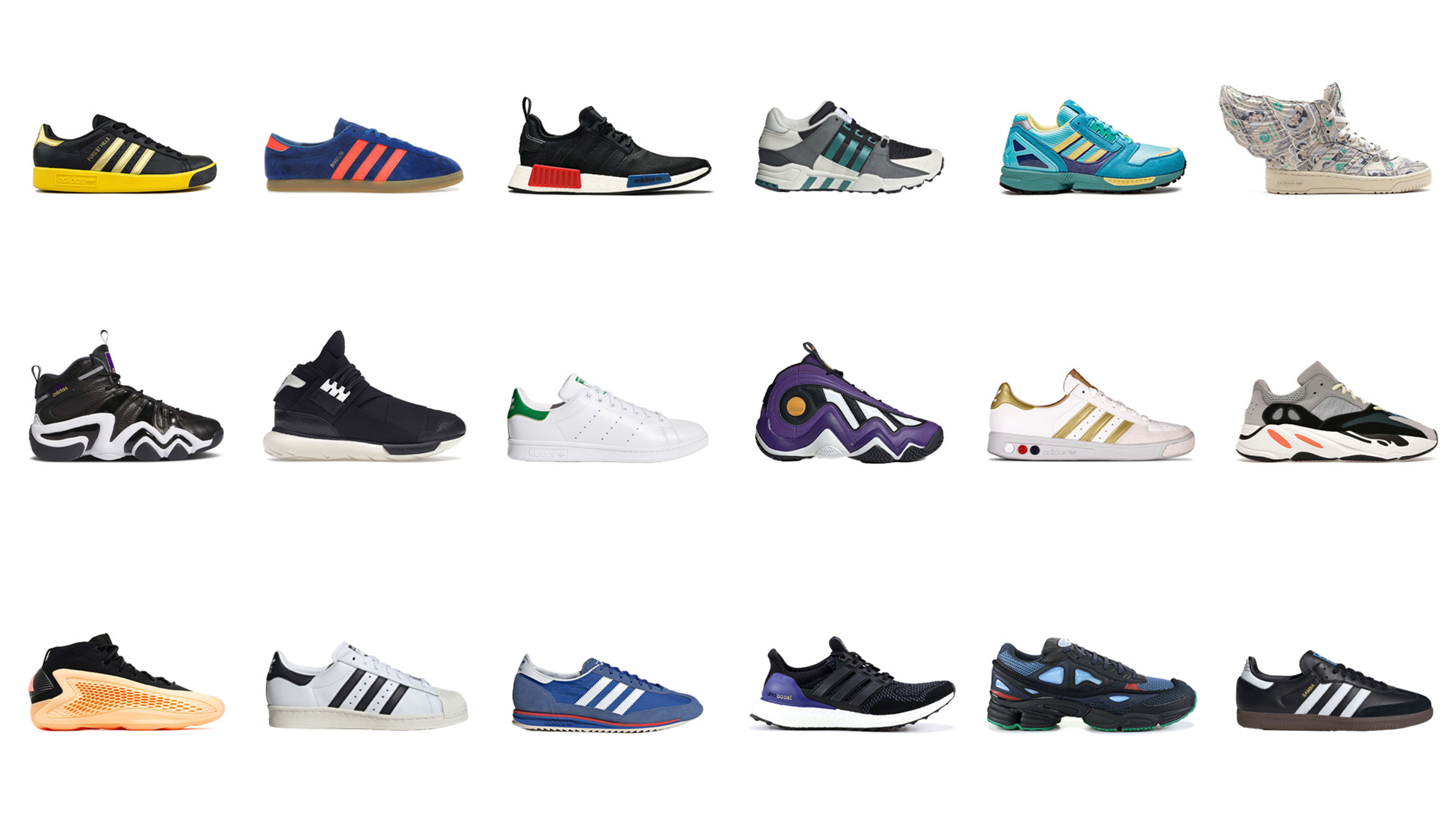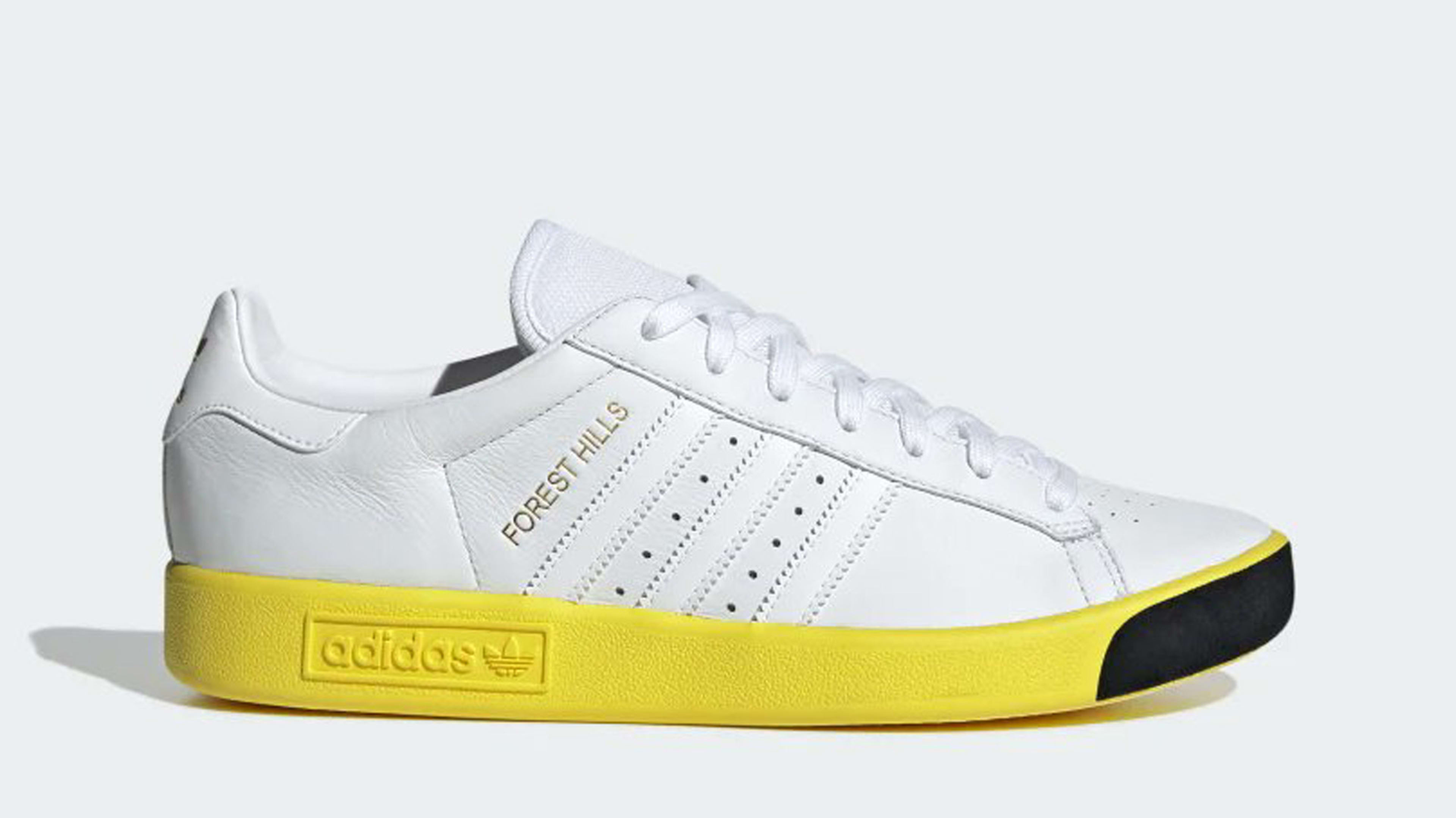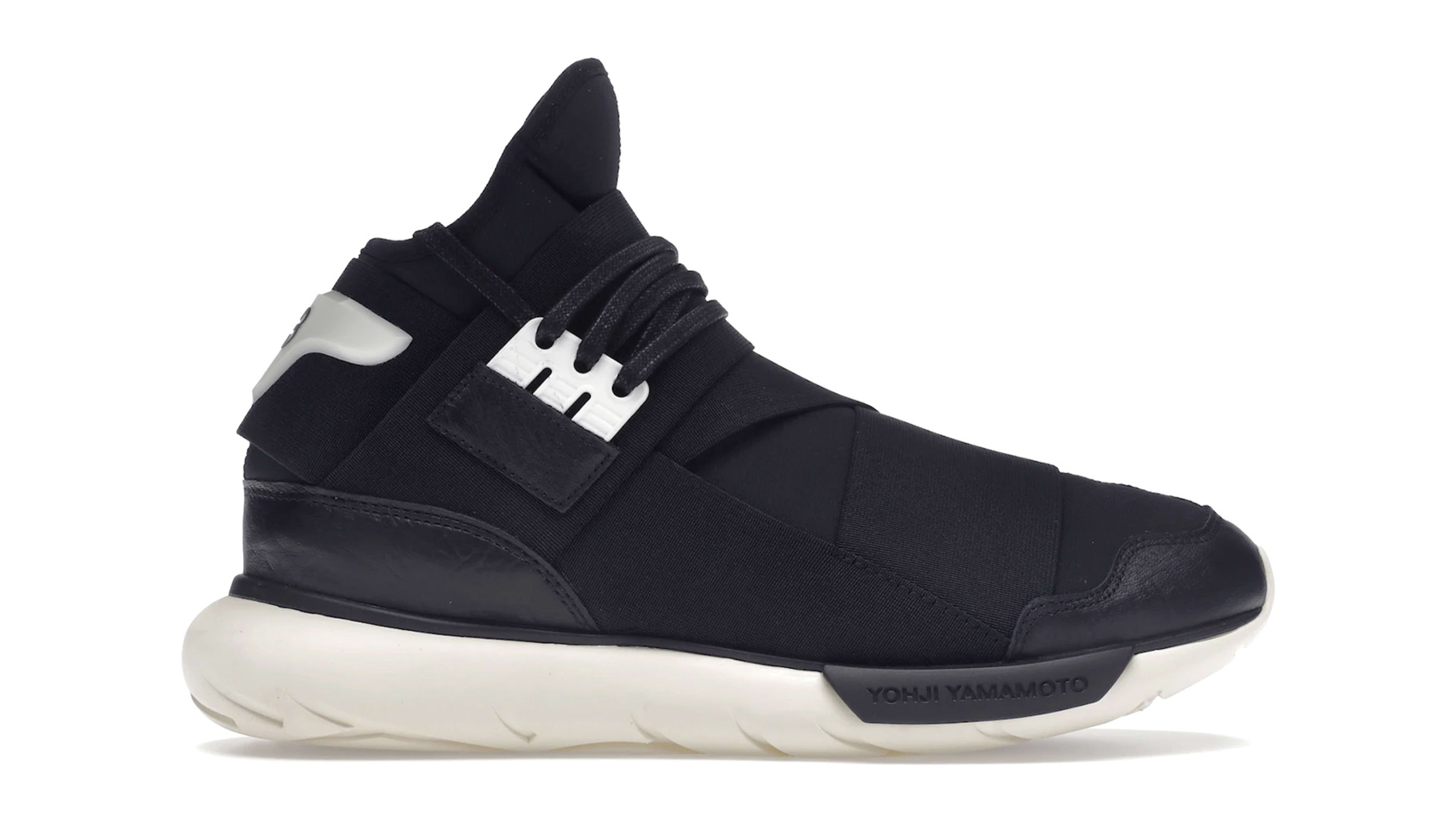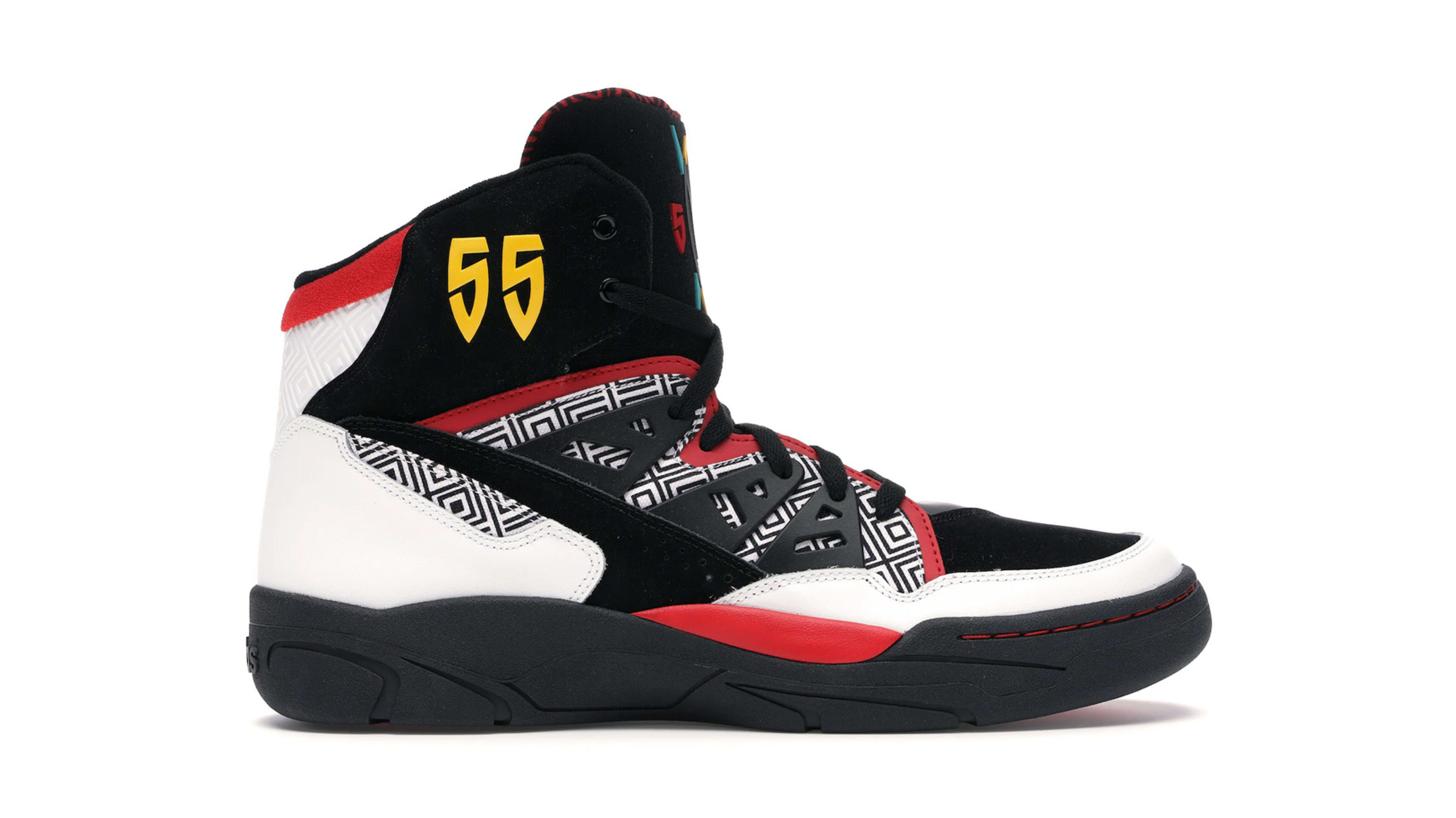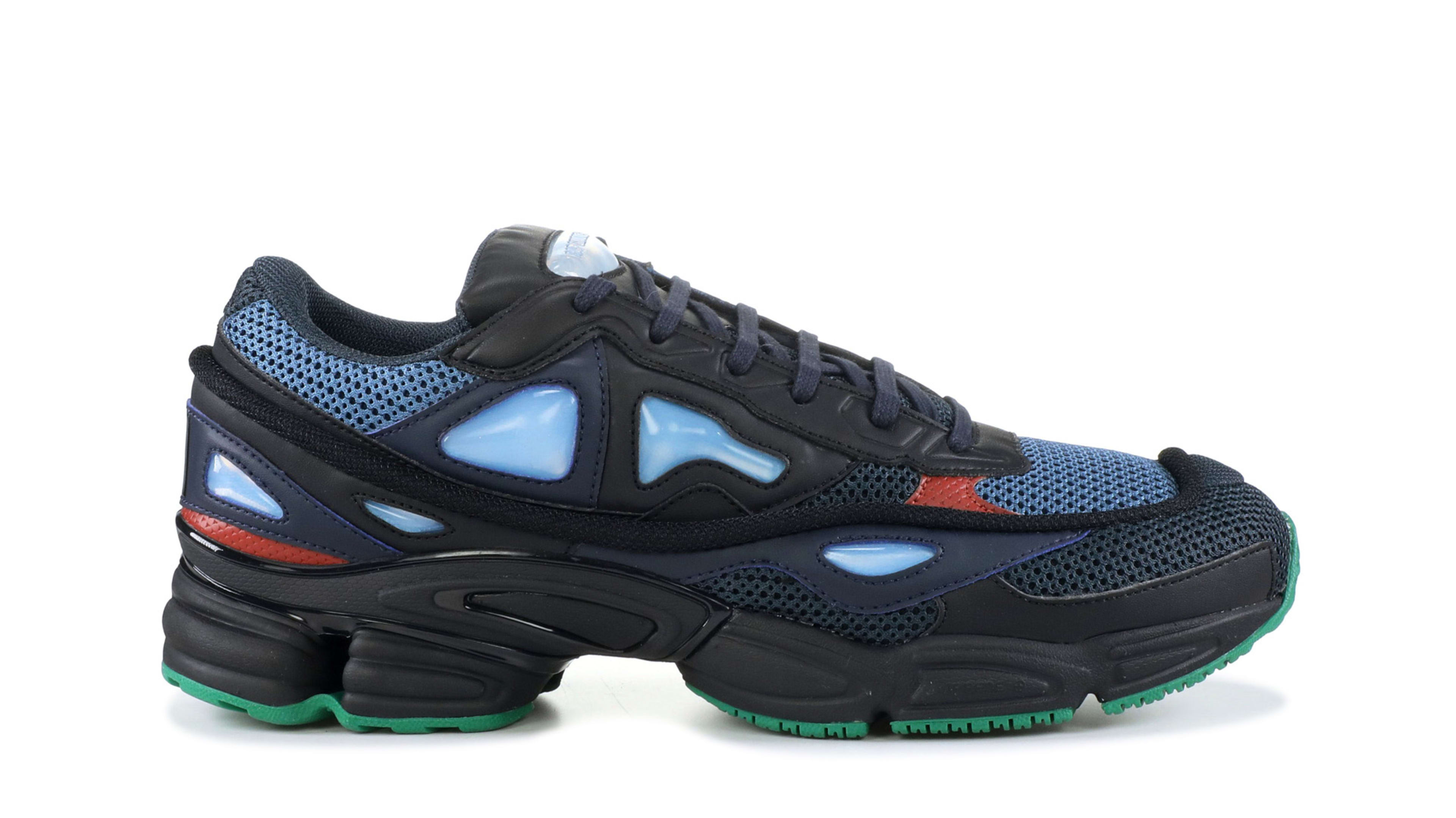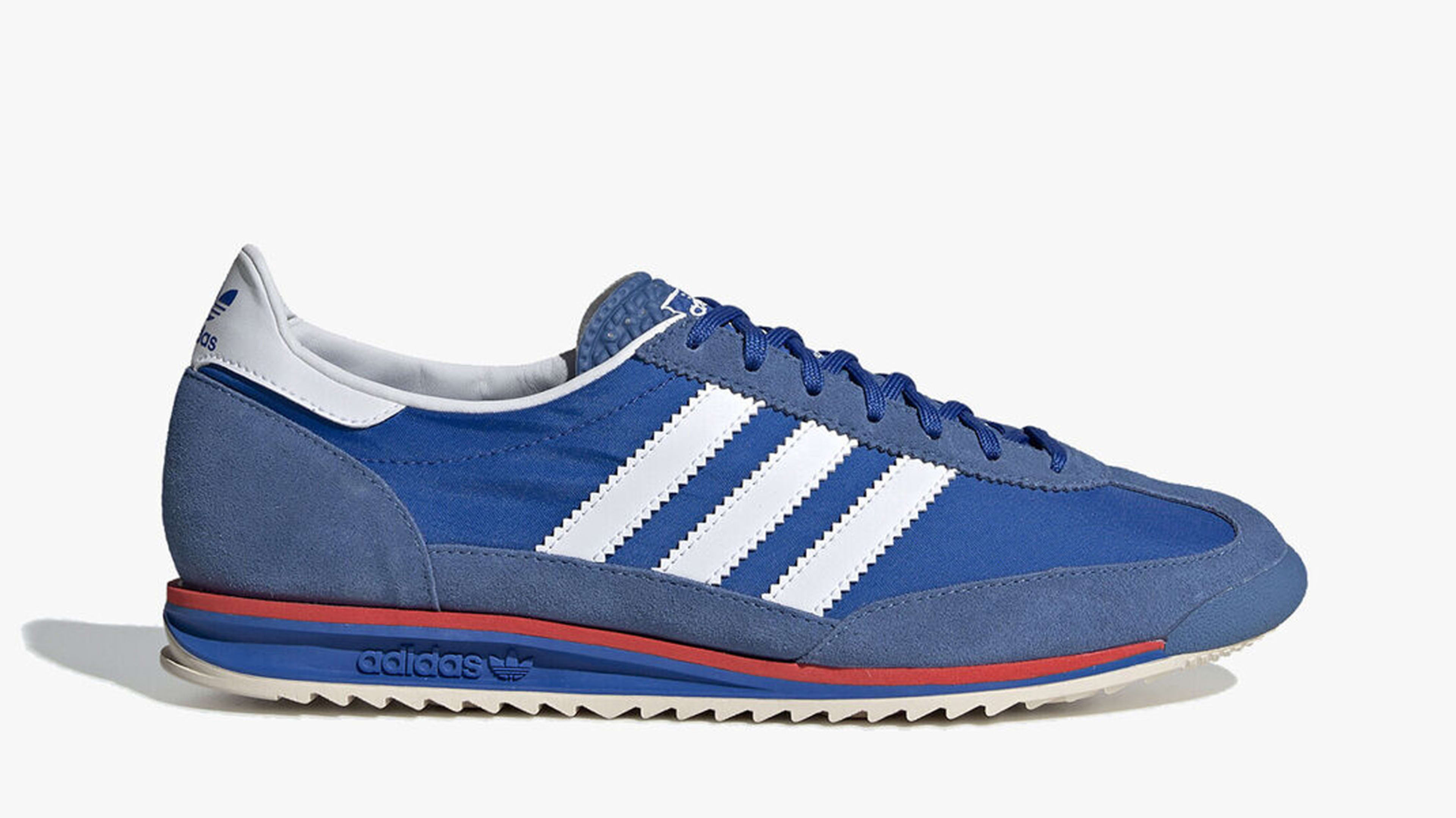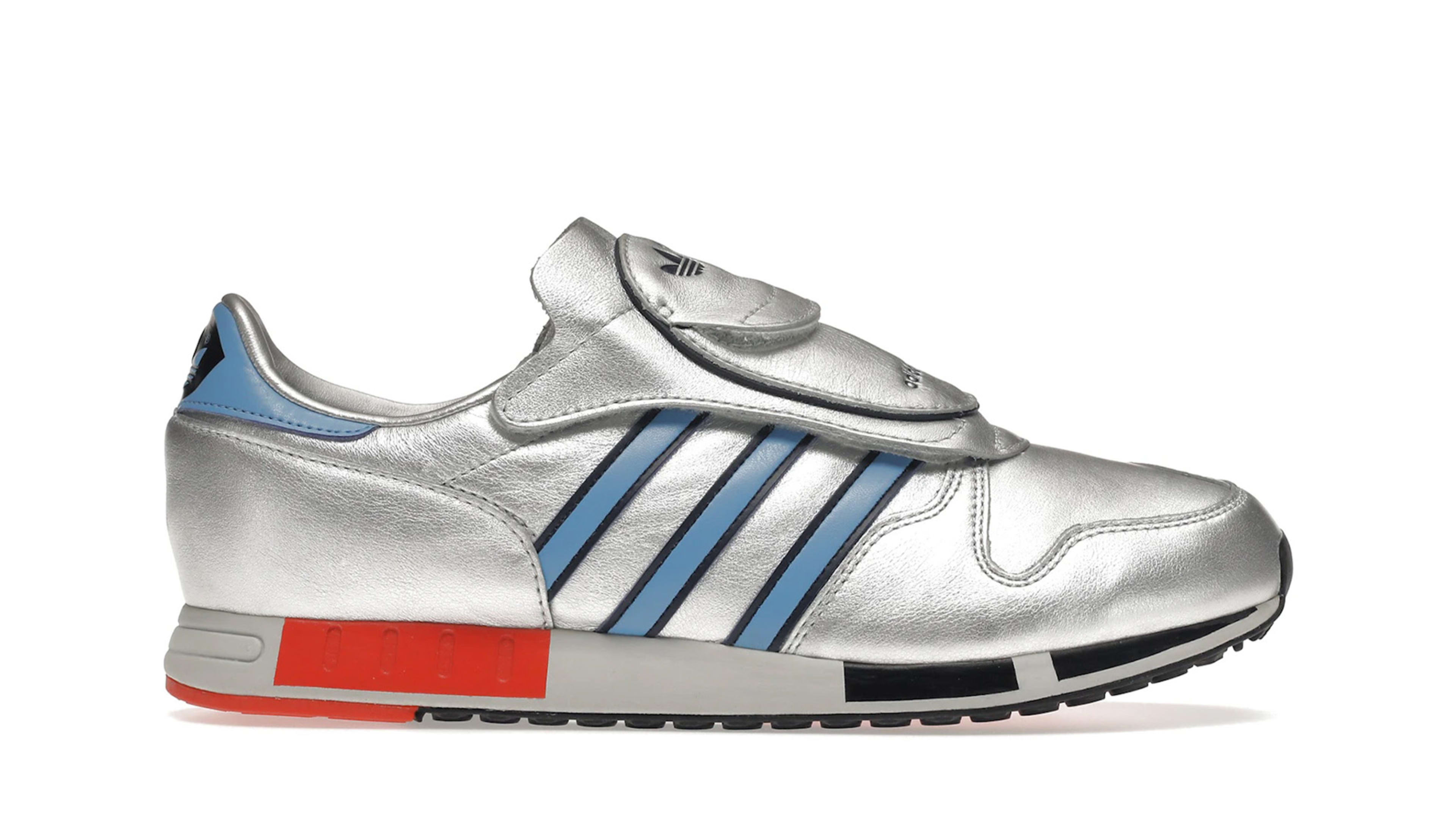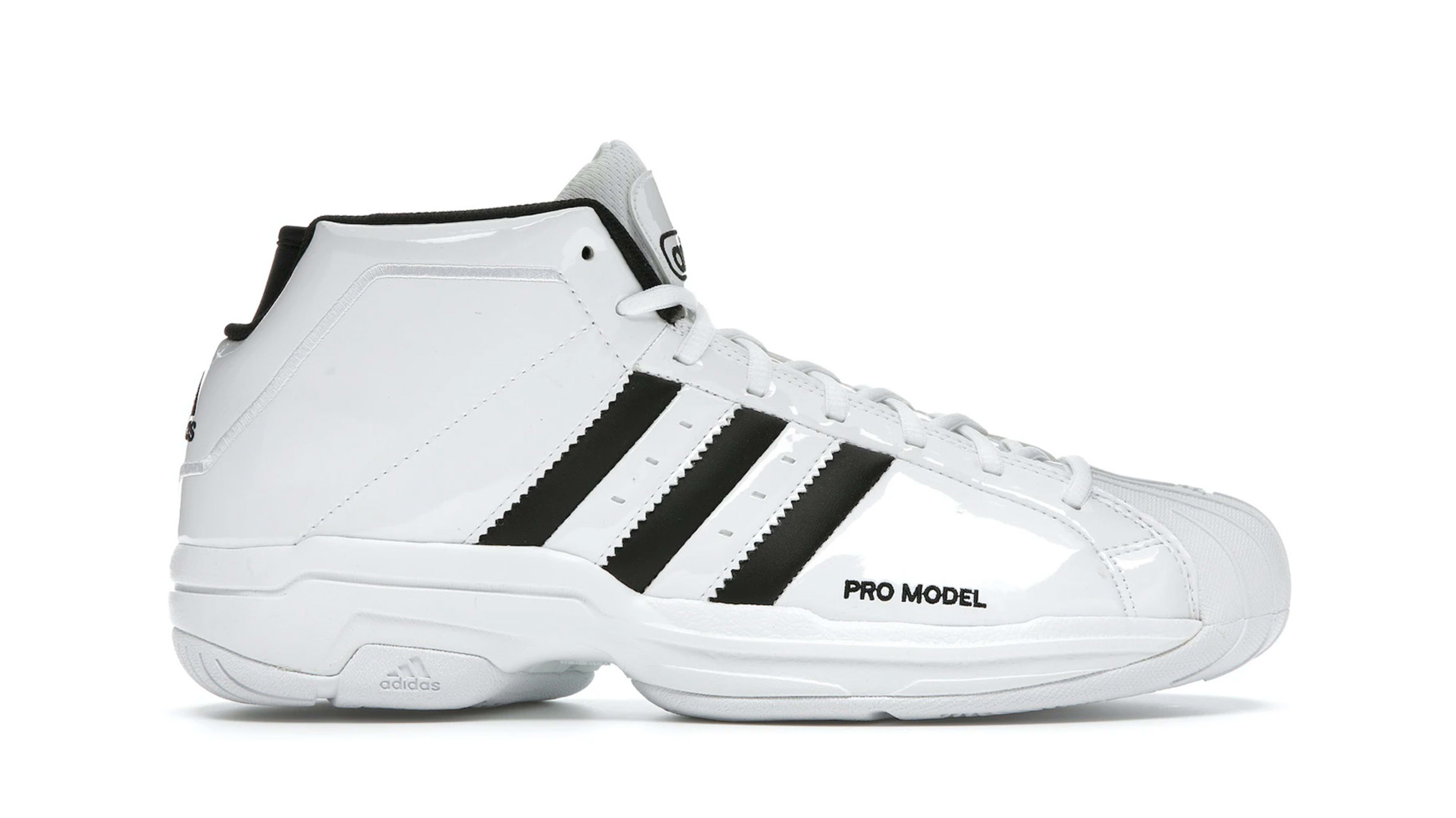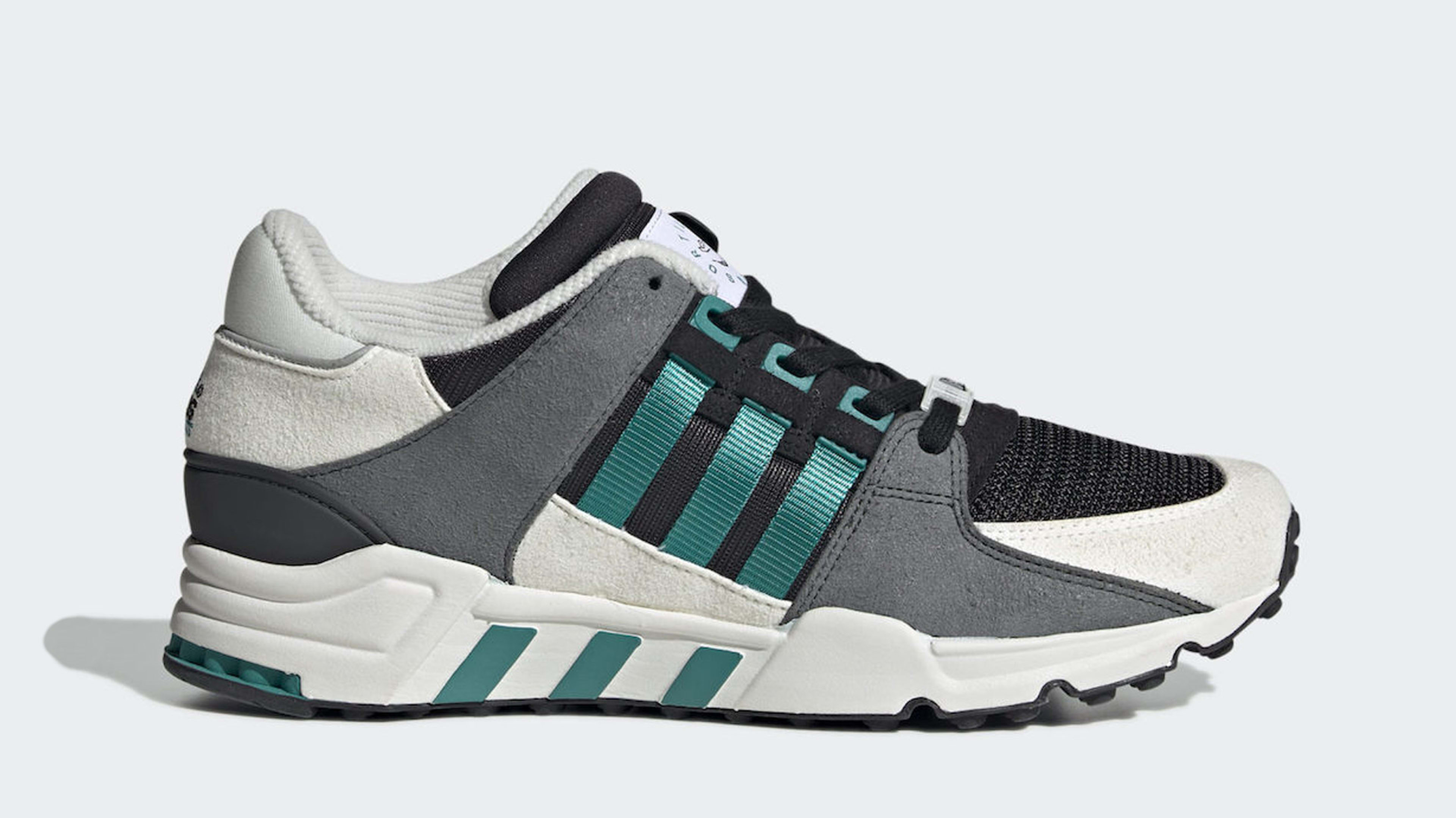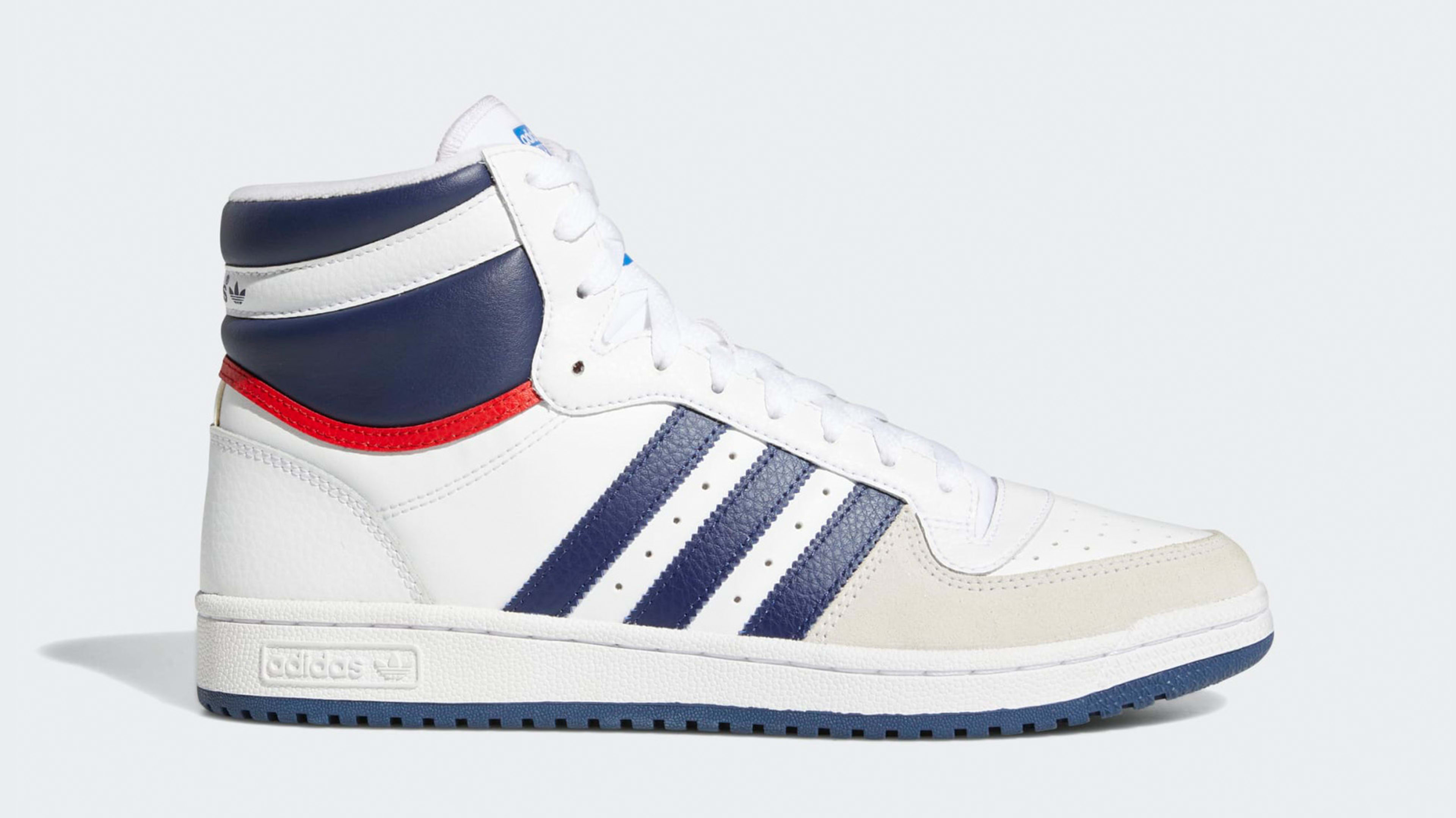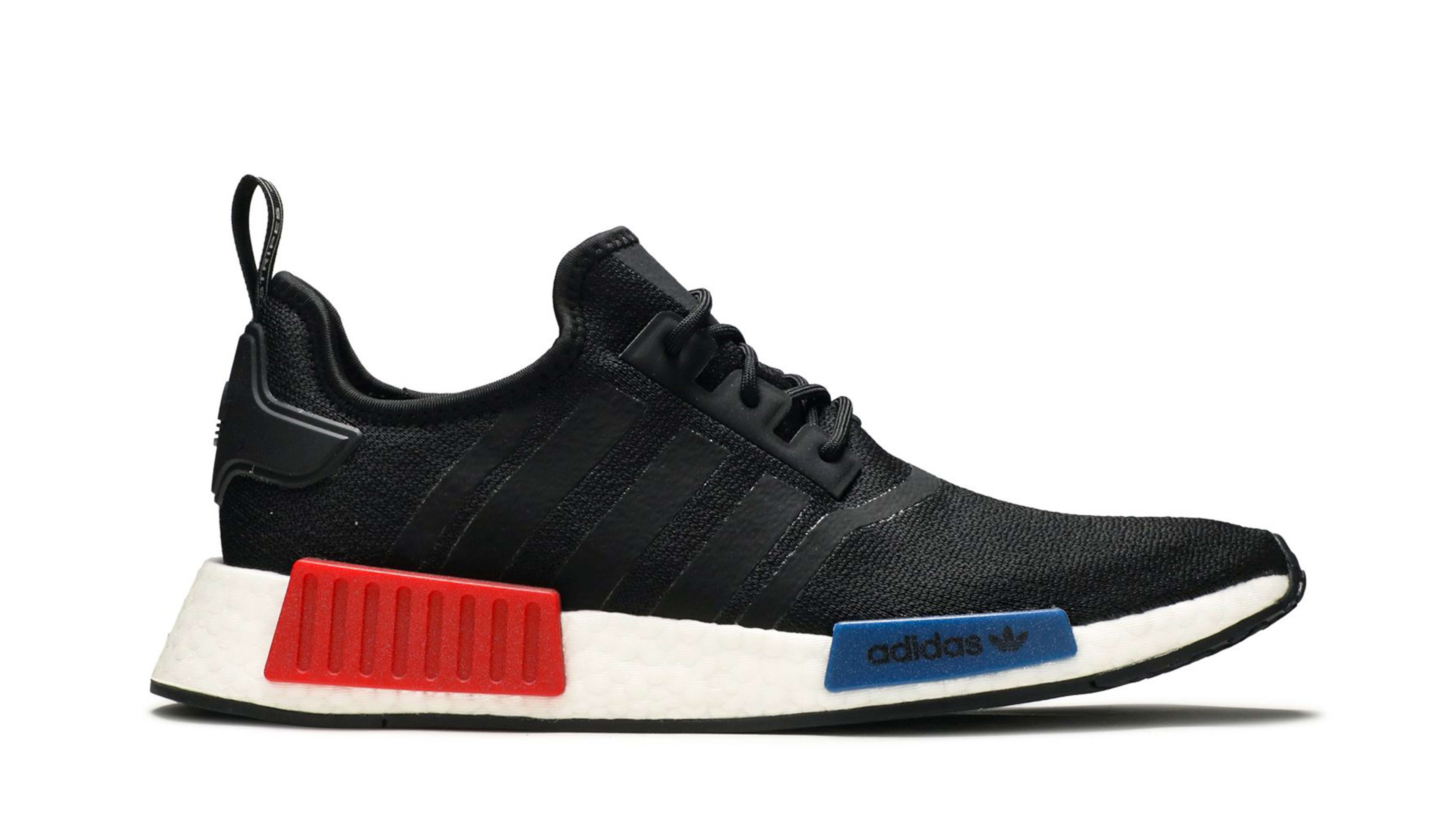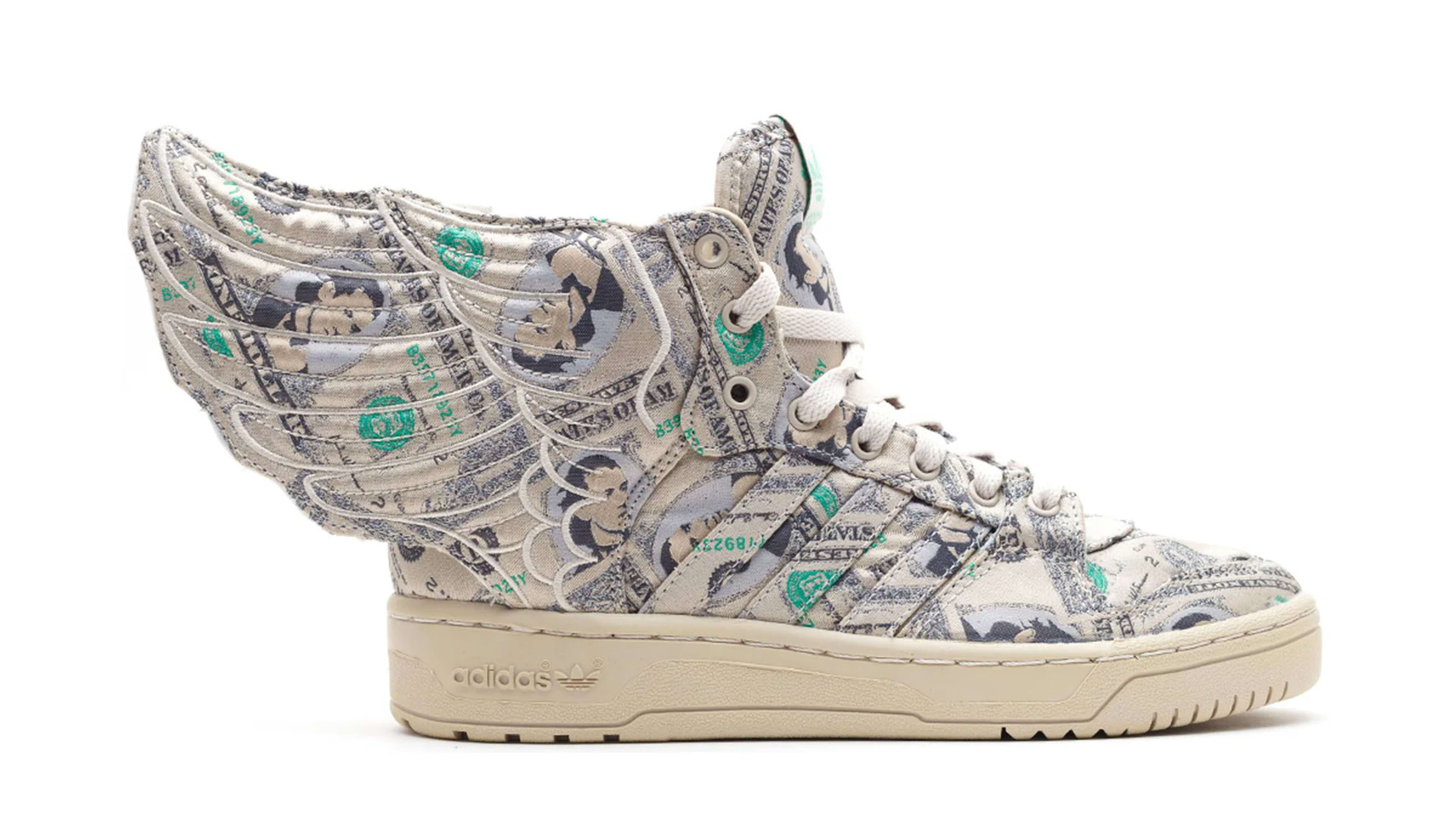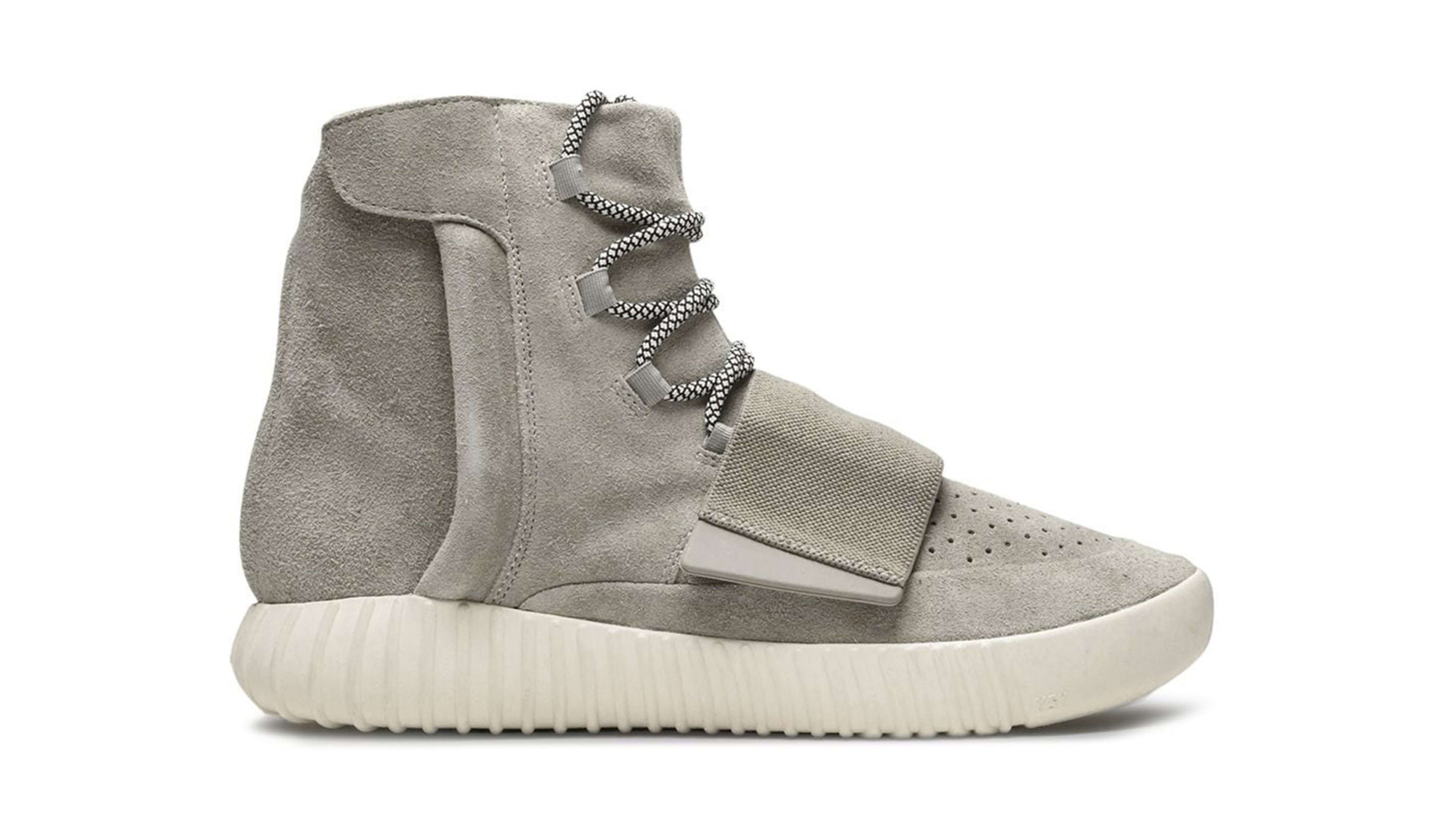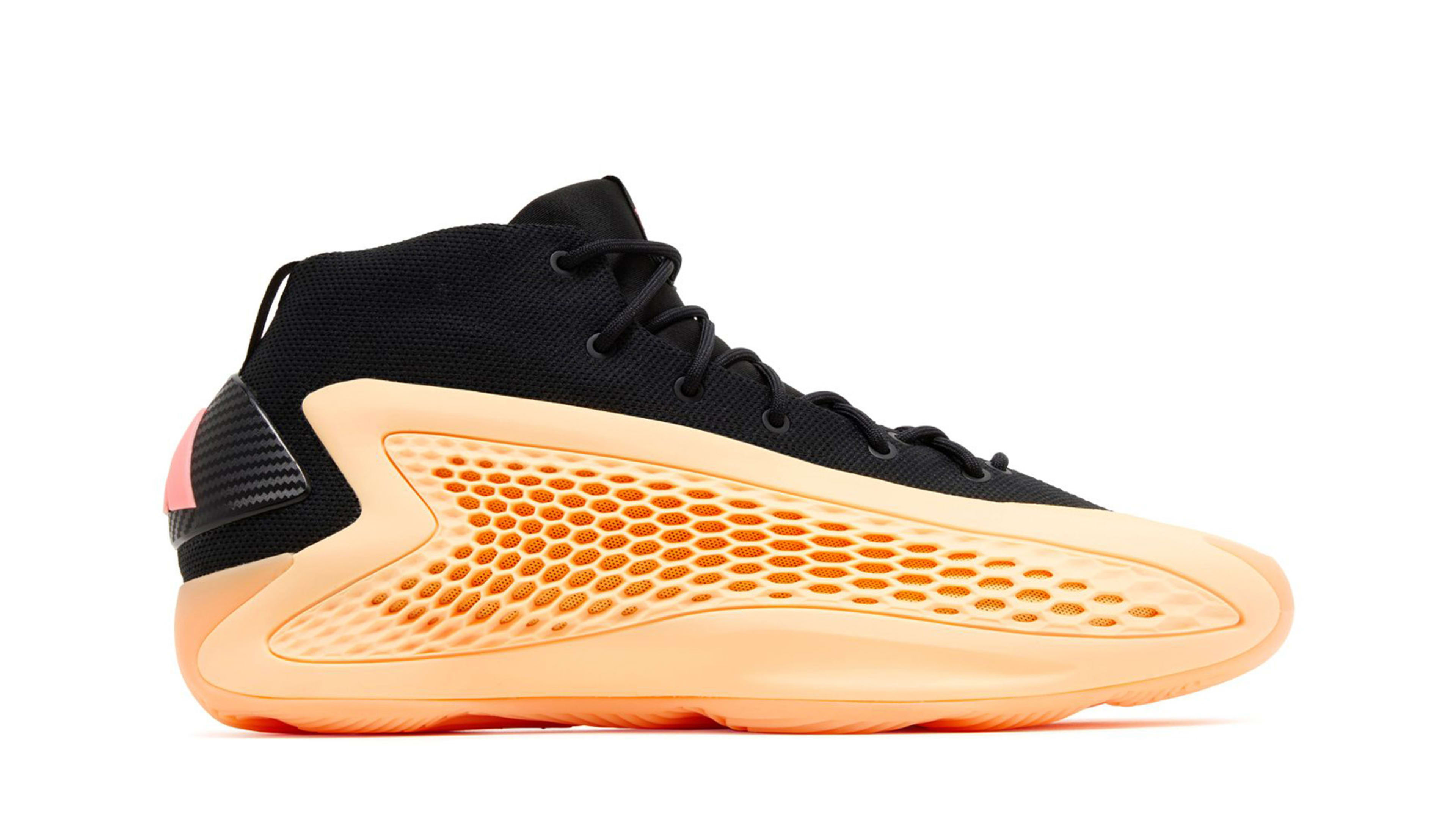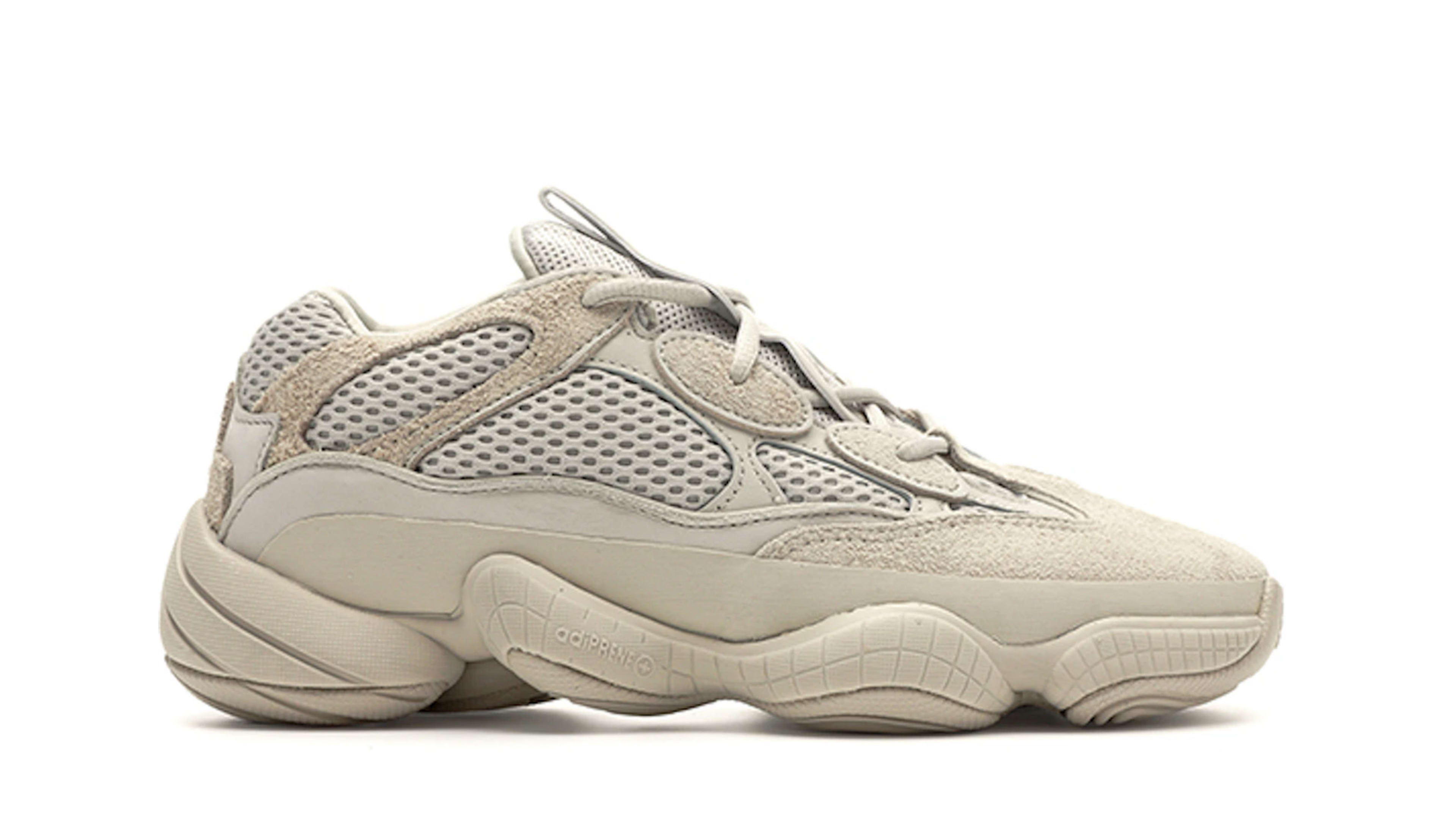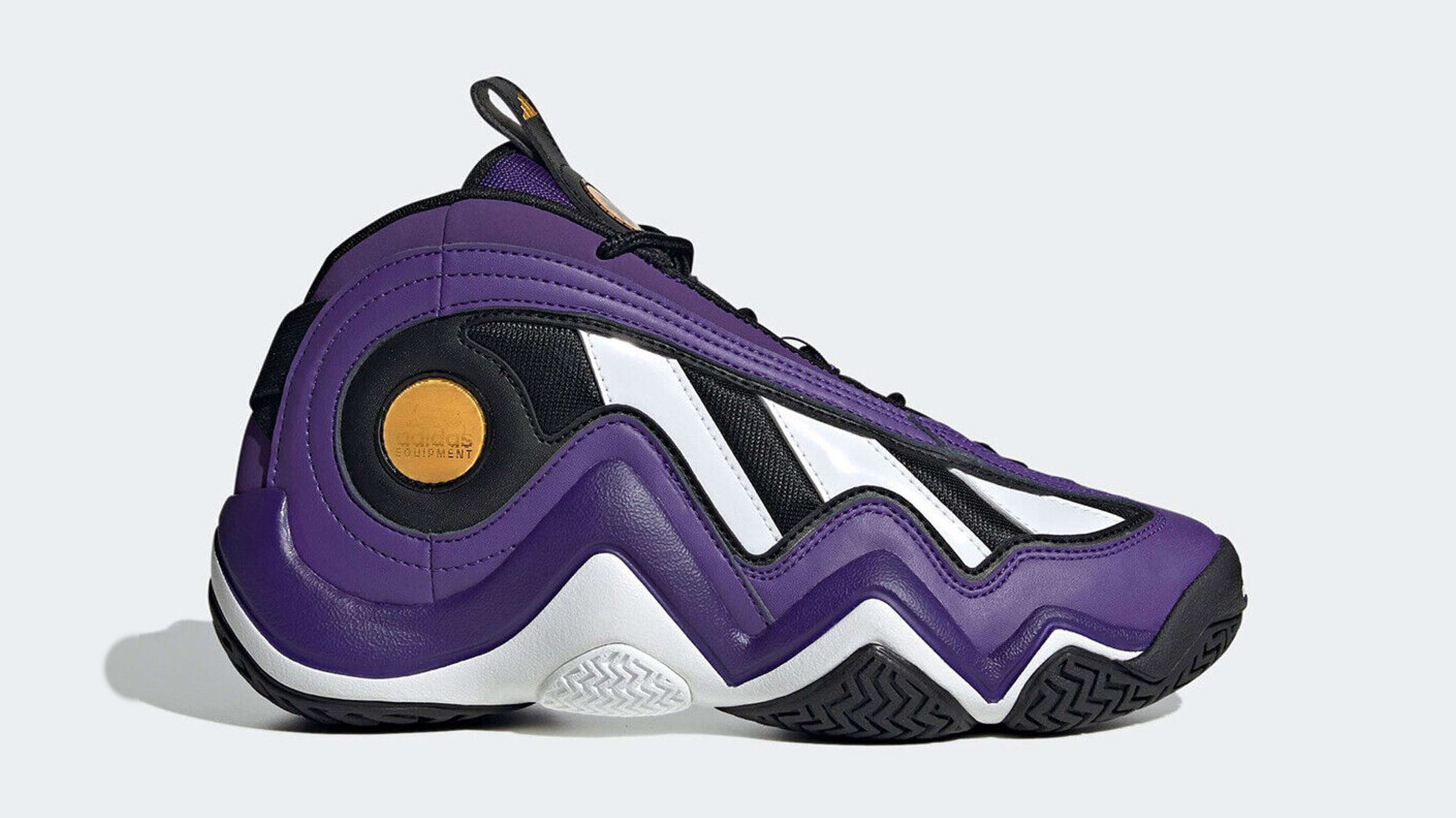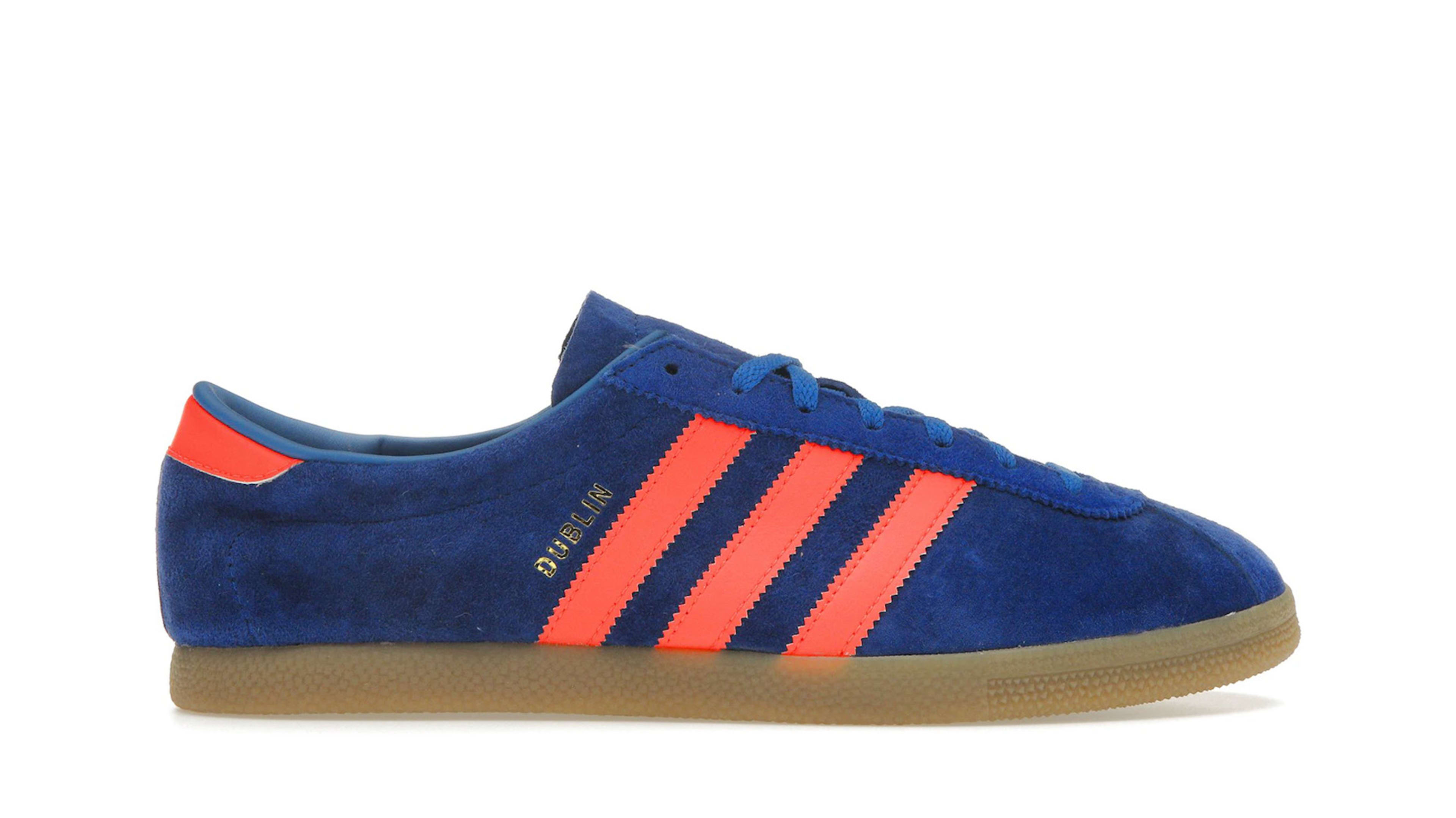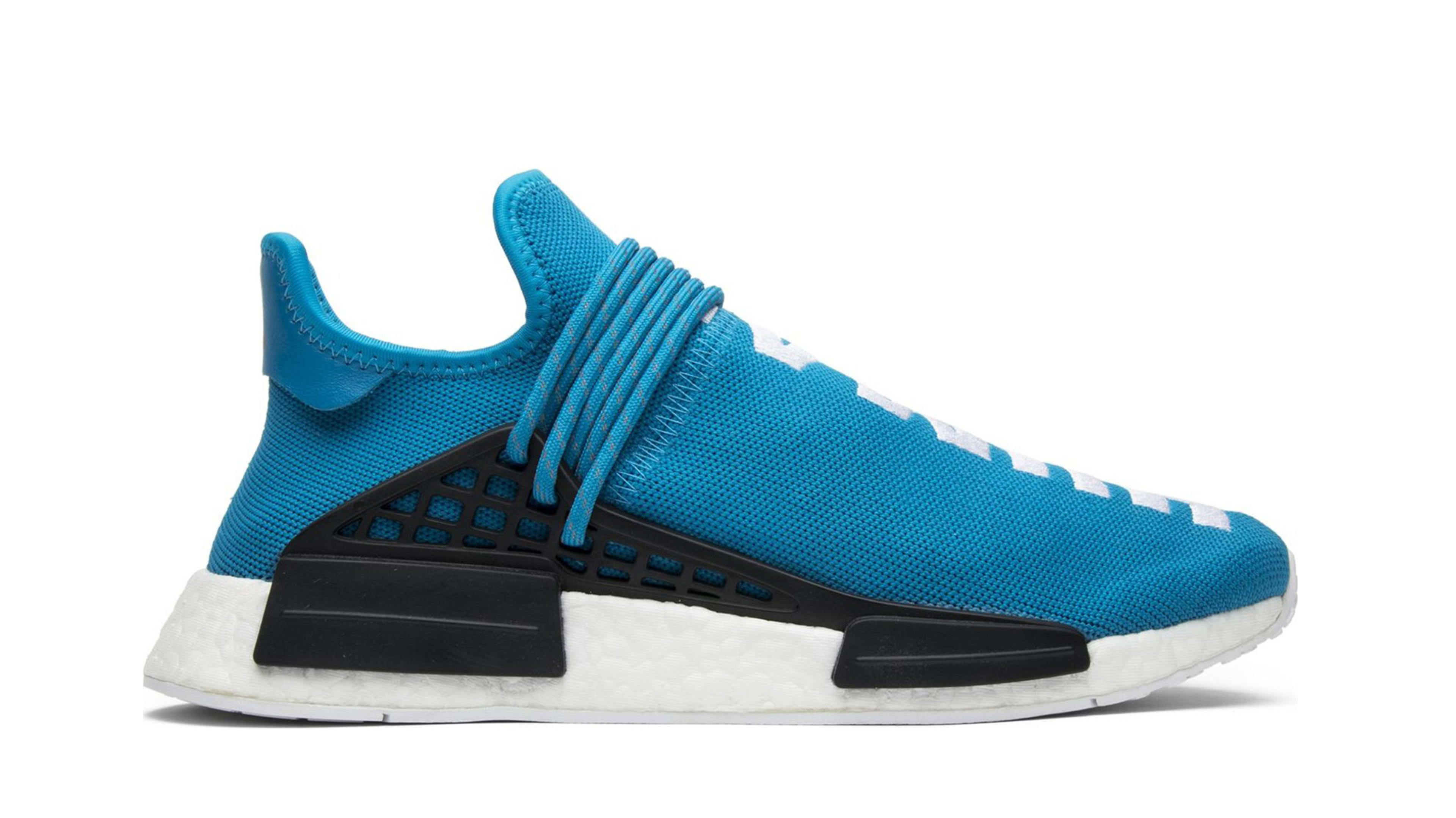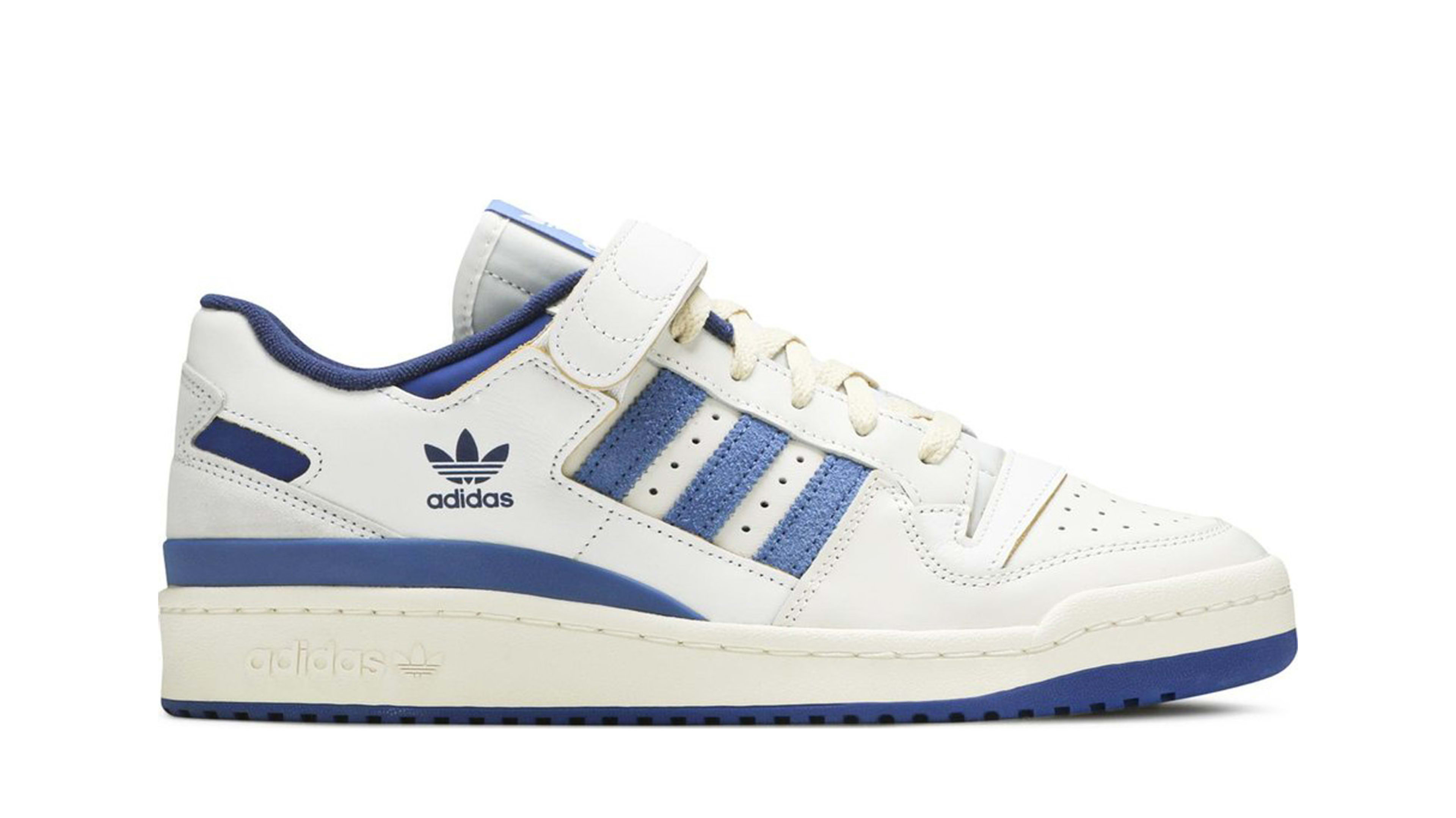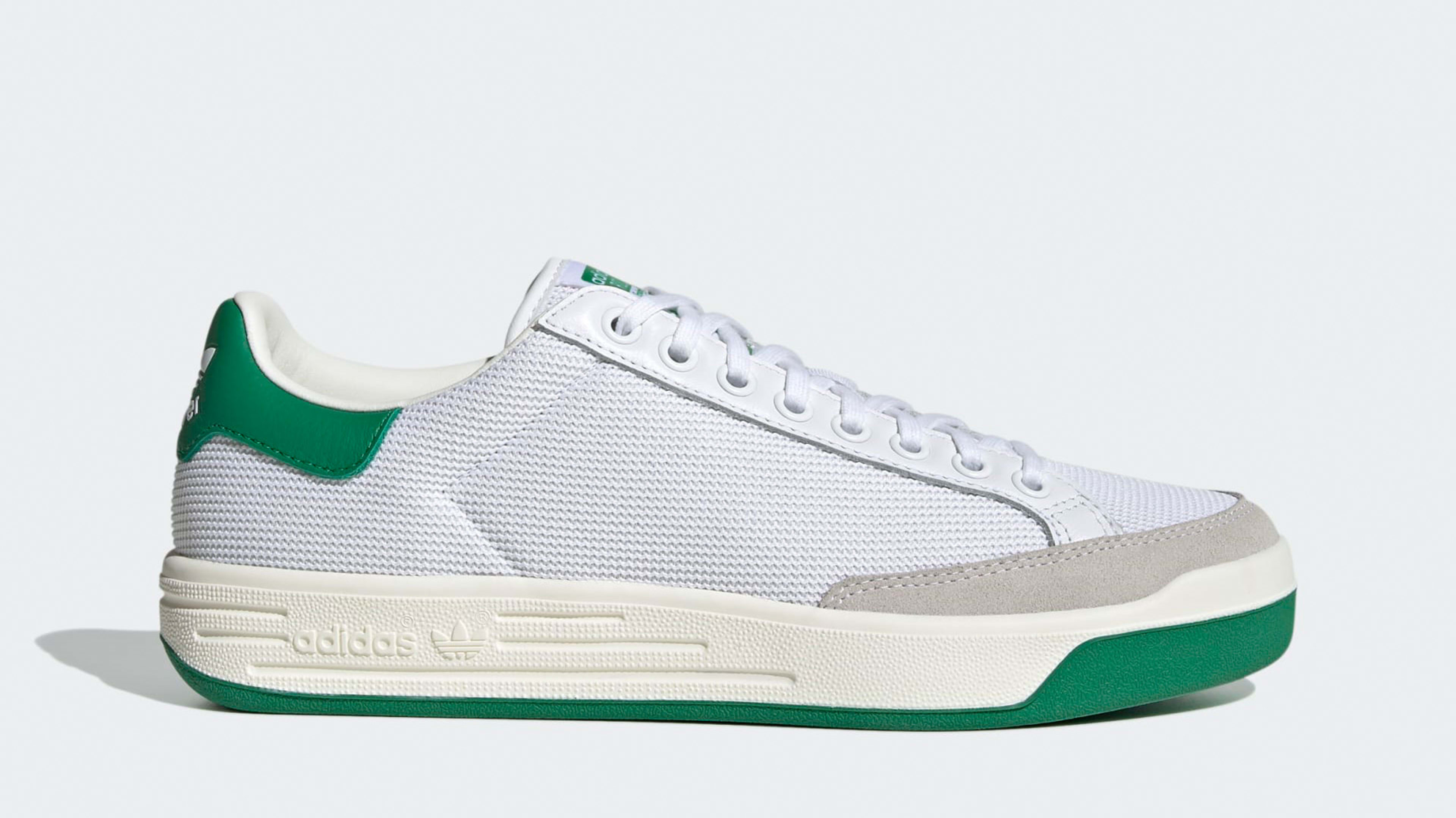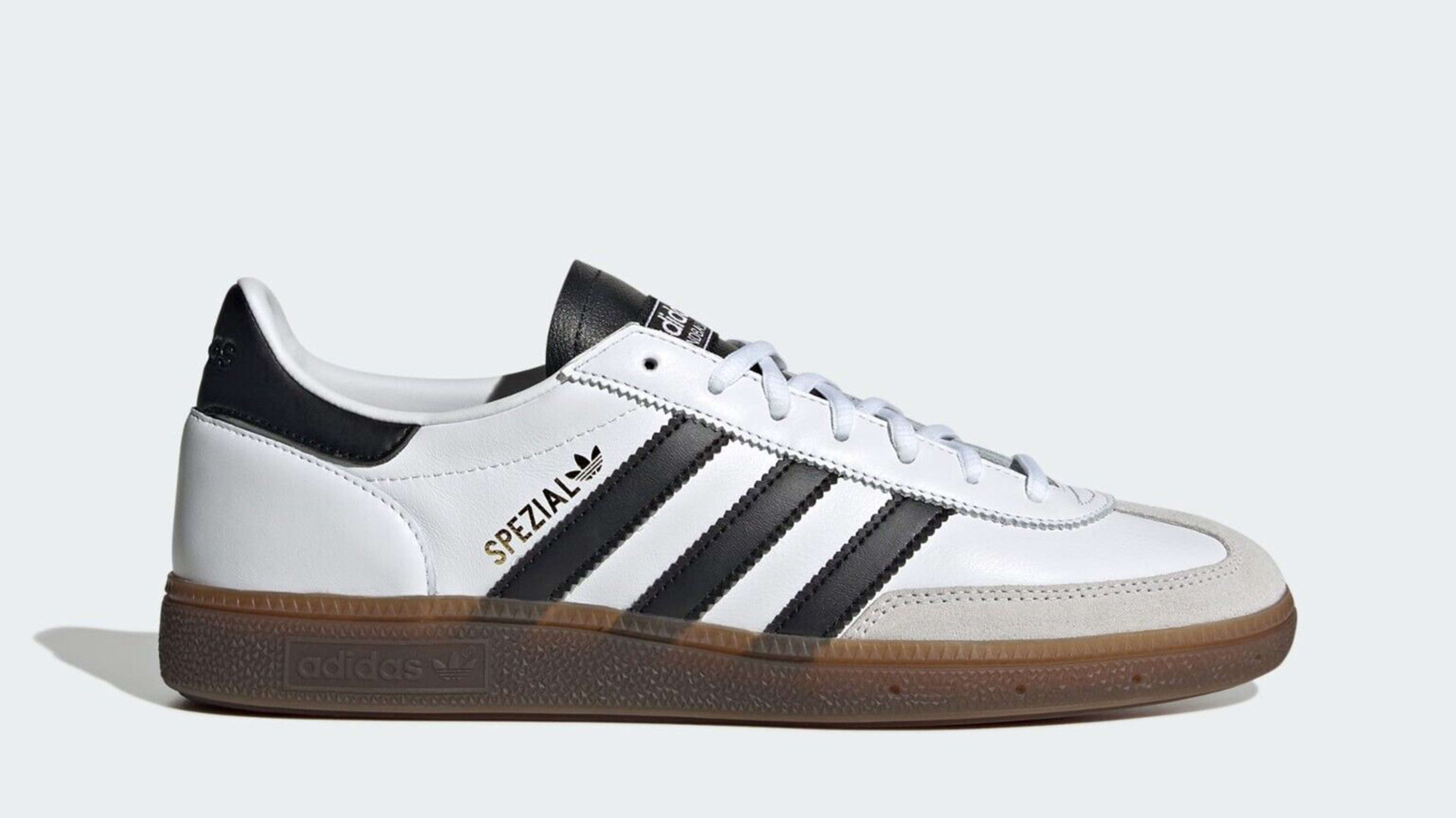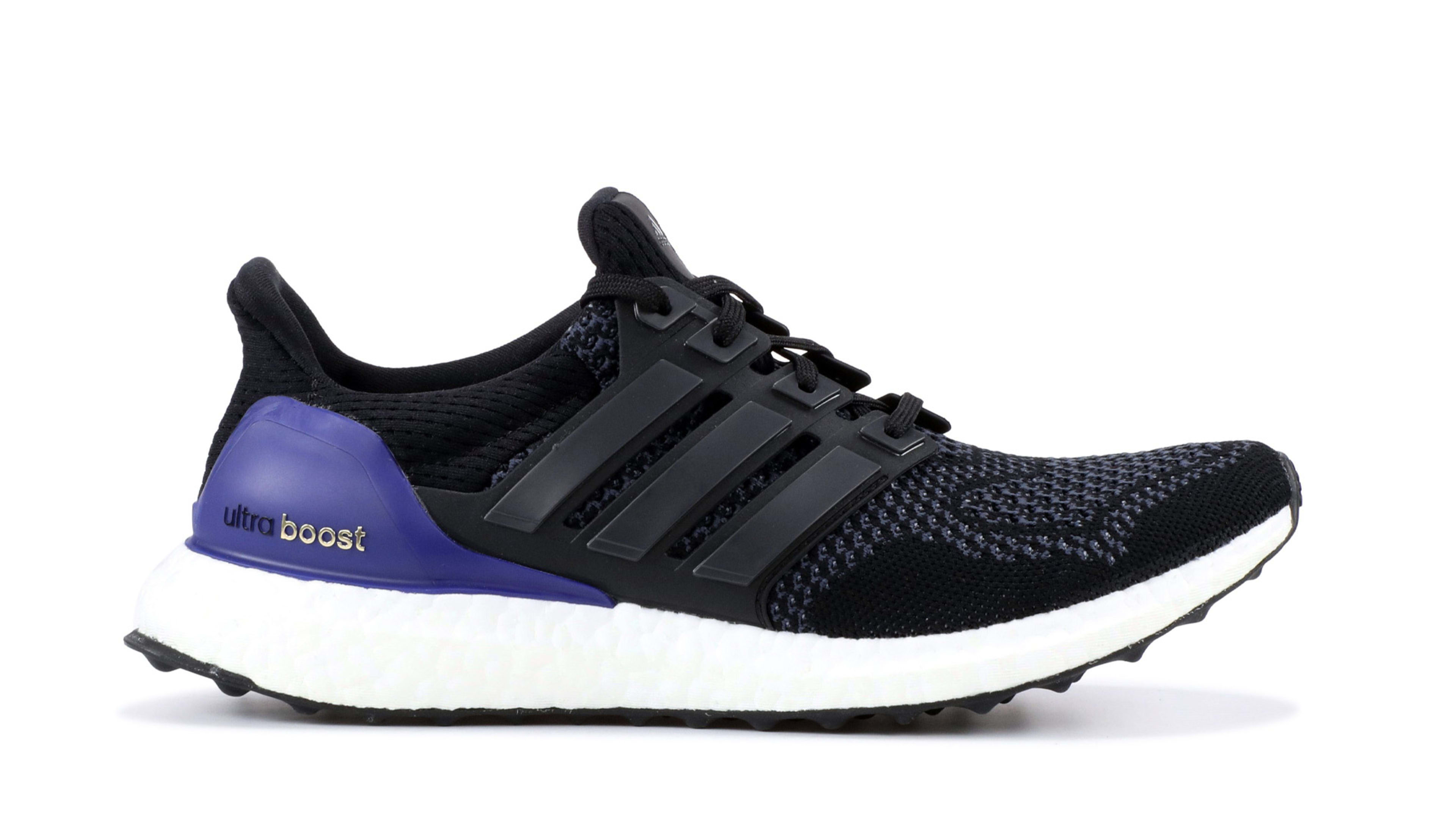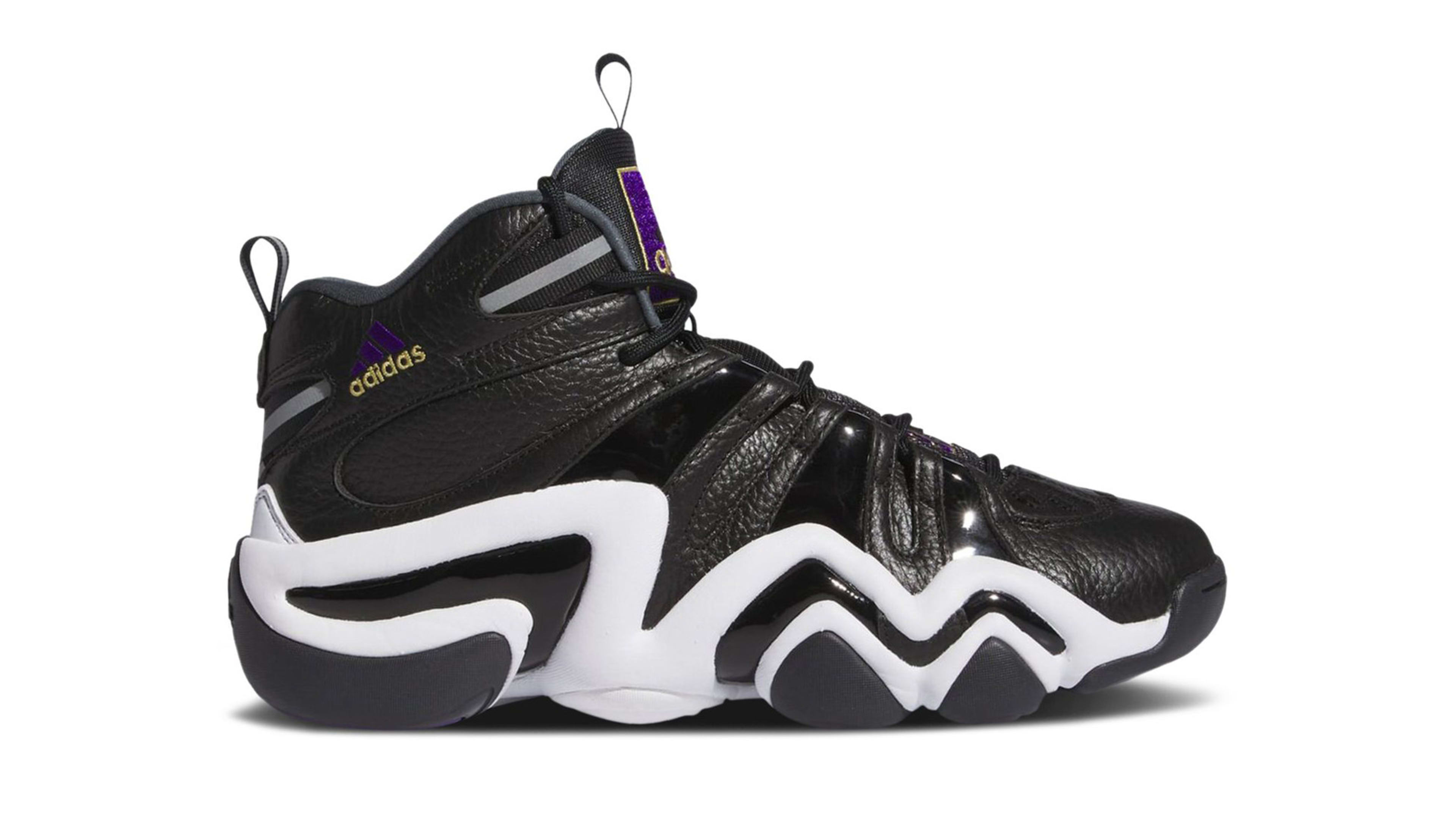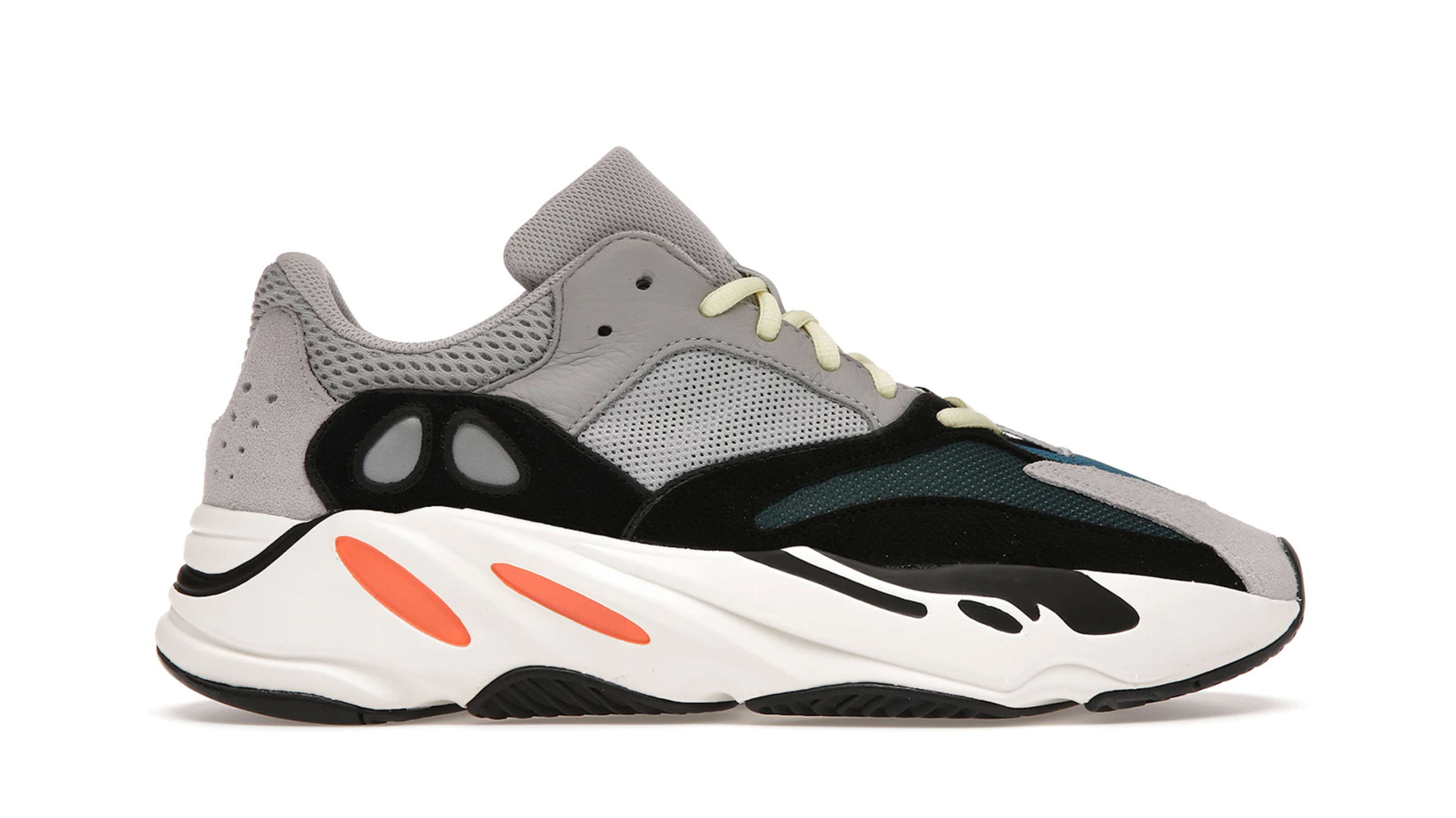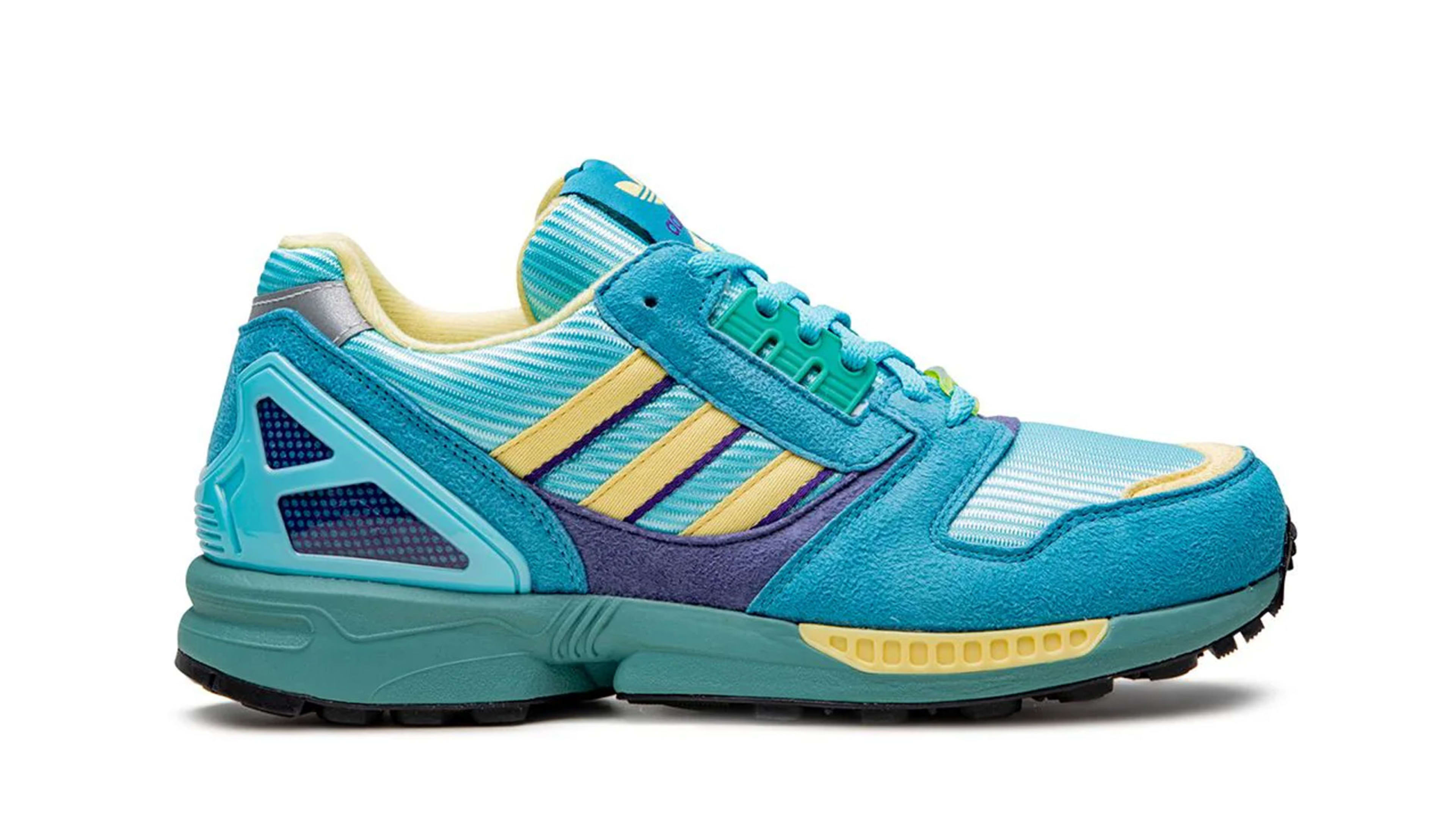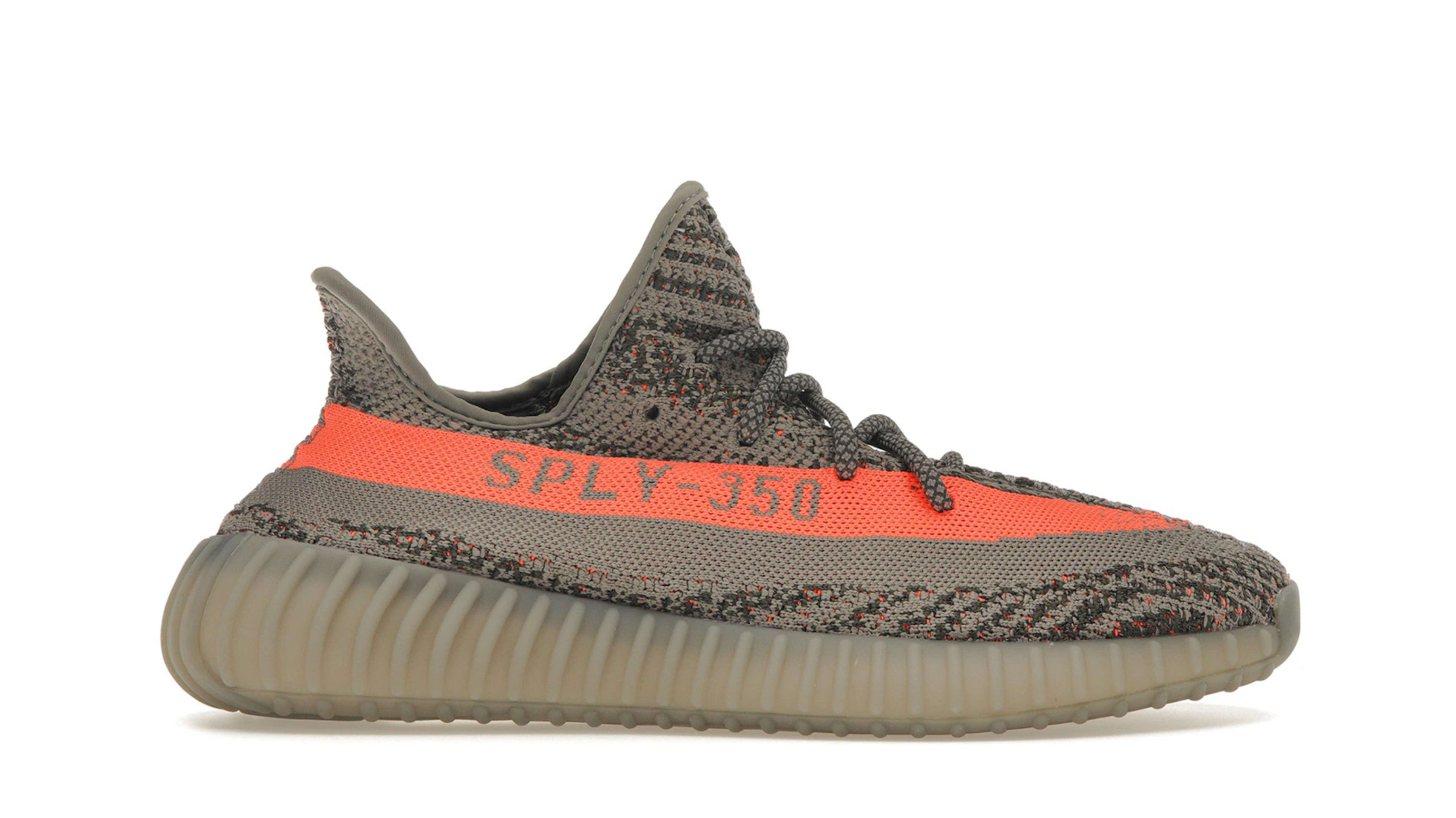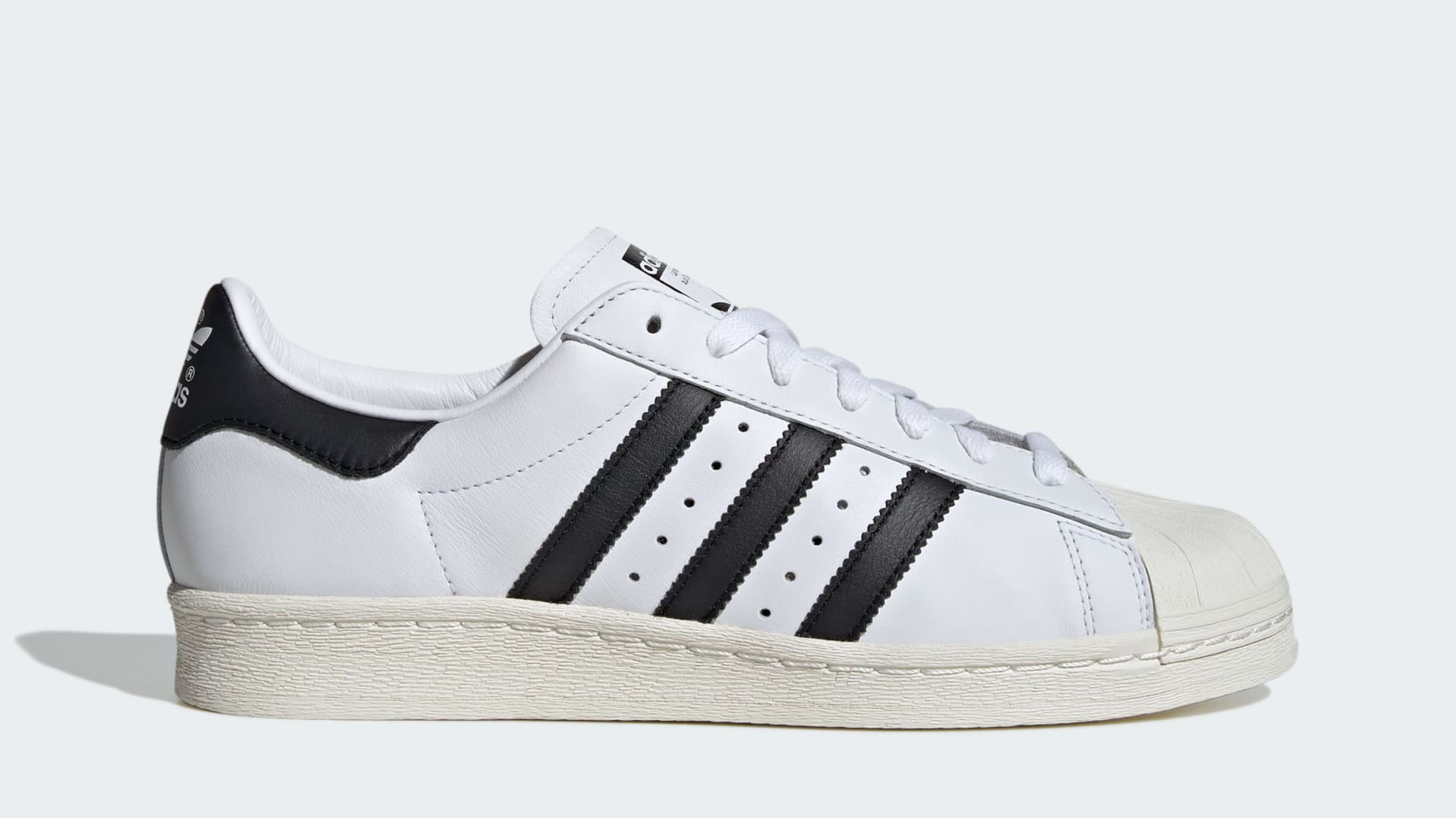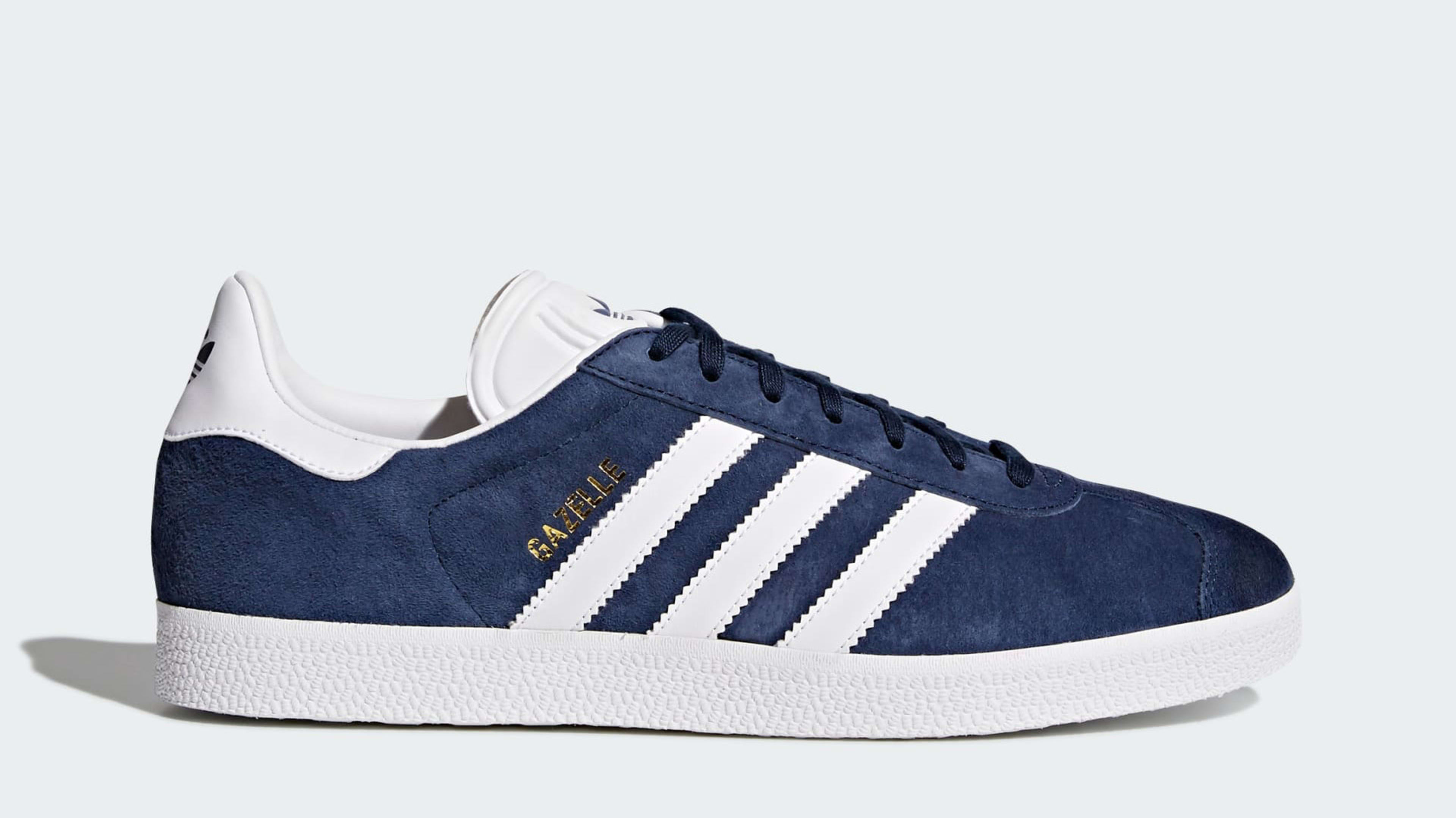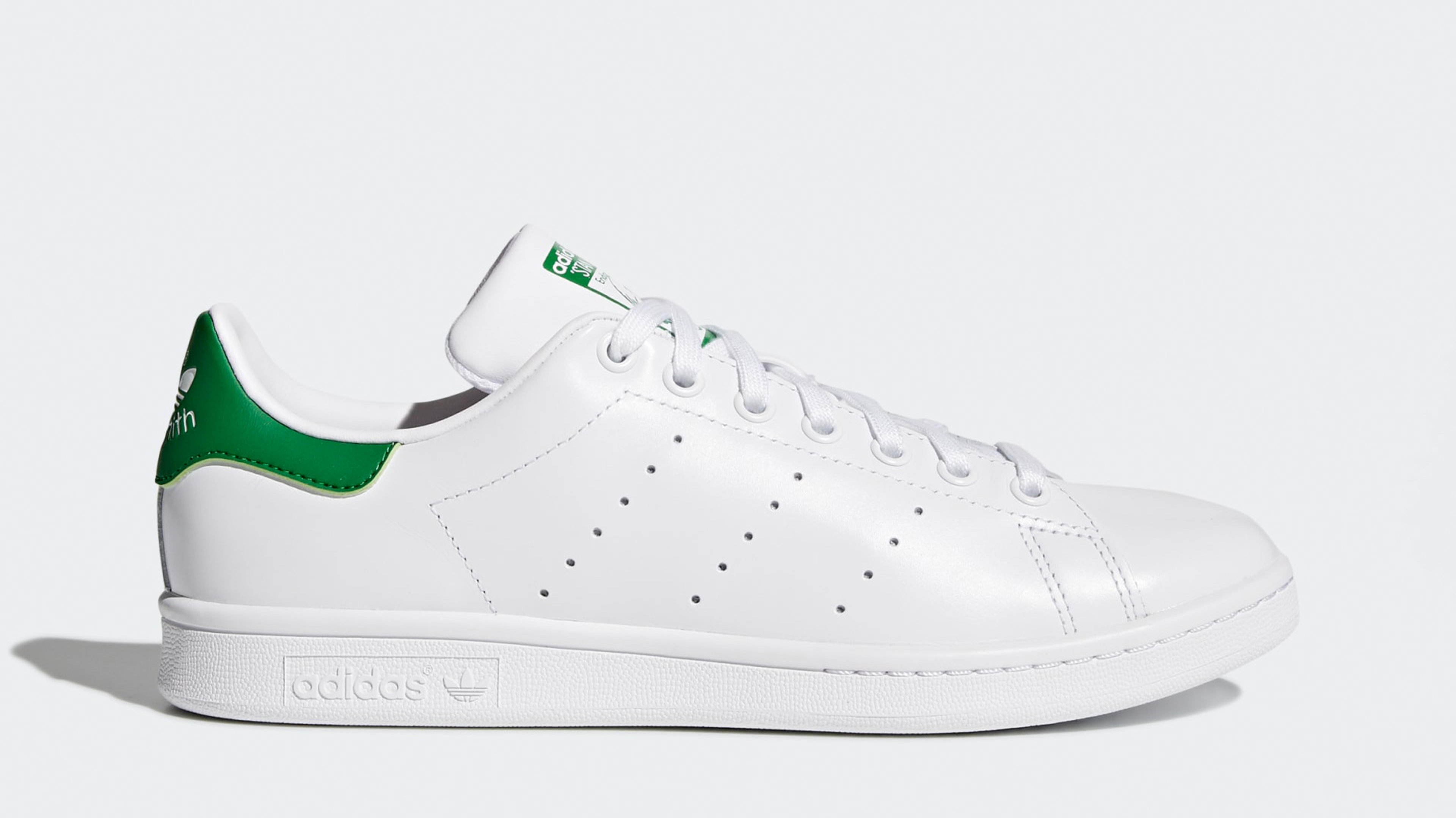The 33 Best Adidas Sneakers of All Time, Ranked
Our picks for the top sneakers in the history of the Three Stripes.
No sneaker brand has been making impactful sports footwear longer or more consistently than Adidas. You might have to look beyond an American bias to see it, but Adidas’ full catalog is rich and massive, stretching back several decades before modern sneaker culture was born. We did our best to crack the codes of that archive here, ranking the best Adidas sneakers of all time.
The rankings consider the shoes diachronically, weighing how they were received when they debuted and how they’ve lived on in the years since. They factor in the specific heat of individual models right now; if there’s a shoe that’s currently on fire, that is reflected in this ranking.
This is not an exhaustive list of every good Adidas shoe. Many were left off. There are more Yeezys that could have been included, because Ye’s influence at the brand really was that major. The Samoa could have made it, although it doesn’t feel like there’s a lot of love for that shoe from sneakerheads right now. So could have a handful of other signature basketball shoes—for Kareem Abdul-Jabbar or Patrick Ewing or Gilbert Arenas. Those just missed the cutoff. (Hopefully you noticed that the cutoff at 33 is not random but a reference to Adidas’ three stripes. Ranking 333 shoes felt like too much.)
If the descriptions for each shoe are not always completely gushing, it’s because we want to consider the pluses and minus of each model. Even the best shoes have points against them—Superstar sizing still doesn’t make sense, you can’t convince us otherwise. Every shoe on this list is not a complete and total classic, that word has been used far too much in sneaker writing, but every entry is a meaningful part of the long, rich story of Adidas.
33. Adidas Forest Hills
Year: 1976
This shoe was, for a long time, a holy grail for football hooligans and diehard Adidas collectors. The Forest Hills was first released in 1976 and named after the neighborhood in Queens where the US Open is played. The sole of the shoe has a foam that was engineered by NASA and, at the time, was billed as the lightest tennis shoe on the market. Its yellow sole, white upper, and gold Stripes made it stand out. The Forest Hills gained notoriety on the streets of Liverpool, where the football casual scene started. It plays a primary role in the film and book Away Days, where aspiring hooligan Cardy sees a pair at the house of seasoned hooligan Elvis. Cardy asks how he can get the shoes and is hit with the response, “Them Forest Hills are all gone kidd’r, they’re gone before they even get here.” There’s also a scene in the film where The Pack, the hooligan group that supports Tranmere Rovers FC, pulls up and beats the living hell out of an opposing firm while wearing the shoes. Moments like this give the Forest Hills a unique history a lot of shoes simply don’t have. —Matt Welty
32. Y-3 Qasa
Year: 2013
The Qasa High, from Yohji Yamamoto’s long-running Y-3 collaboration with Adidas, has probably never gotten the credit it deserved. Influence from its sock-like upper combined with Adidas’ archival Tubular sole technology was seen across the industry in the years that followed its 2013 release. From the Yeezy line to the reintroduction of Tubular franchise at a mass-market price point, the style was everywhere. That’s not to say that the Qasa was overlooked, but at a $385 retail price, and thanks to the relatively niche appeal of Y-3, it was far less celebrated than many of the shoes that it inspired. The sneaker was so integral to the line that it returned in 2022 for the 20th anniversary of the Y-3 project. —Zac Dubasik
31. Adidas Mutombo
Year: 1993
The Adidas Mutombo was born under circumstances that could have yielded an all-time classic sneaker. When Mutombo signed with Adidas, for upwards of $1 million in 1992, the signature shoe market for basketball players was not yet crowded—it was pretty much just Michael Jordan alone on top of the world. The Mutombo line at Adidas was designed by footwear titans like Jacques Chassaing, who did the ZX8000, and Peter Moore, who defected to Adidas after getting Air Jordan off the ground. Mutombo was developed into a signature star by Sonny Vaccarro, another man instrumental in the Air Jordan deal. The product was bold, embracing Mutombo’s Congolese background with African-inspired prints and a shield signature logo that represented, Mutombo said, his shot blocking prowess and “protecting my kingdom.” The marketing even dared to take a shot at Jordan—Mutombo declared in a commercial in his Cookie Monster growl that, “Man does not fly in the house of Mutombo.” Wu-Tang member Raekwon, a man whose co-sign could make gear iconic in the ‘90s, wore the Adidas Mutombo in a photo for the album booklet of the New York group’s debut album. And yet, the Adidas Mutombo is not quite a classic. The sum of its parts was not enough to truly compete with Jordan, let alone any of the other exciting things happening in that era of sports footwear. It’s an important shoe though, even if it might ultimately be most important for reinforcing the old cliche that big men don’t sell shoes. —Brendan Dunne
30. Raf Simons x Adidas Ozweego 2
Year: 2017
How good is this shoe? Good enough to convince a whole generation of kids who didn’t know the first thing about Raf Simons to spend several hundred dollars on his sneakers. The name doesn’t really matter here, the shoe is just that cool. Even the Ozweego name doesn’t mean much—these are only nominally related to the original Adidas Ozweegos. What does matter is the funky, chunky design, blasted with jeweled bubbles on the upper that look like they would give you special powers in a video game or, should you pluck one off and try and chew it down, the sustenance you need to finish a marathon. Designer crossover shoes got pretty tired at the turn of the last decade, but Raf got in while things were still interesting. —Brendan Dunne
29. Adidas SL 72
Year: 1972
The Adidas SL72 should be remembered for a number of reasons. For one, it has Olympic pedigree, having been introduced around the ill-fated Munich Olympics in 1972, where the shoe appeared on podiums. It’s also memorable as the sneaker that introduced the world to Adidas’ now iconic trefoil logo, which was brand new back in ‘72. You’d do well to remember its place in Starsky & Hutch—Paul Michael Glaser wore a version of the SL72 as Sergeant David Michael Starsky. The “Super Light” Adidas stuck around for much of the 1970s, becoming a T-toe staple in that decade. Not all of its history need be remembered. The SL Loop from 2014, which interpolated the original, wasn’t necessary. Nor was the controversy around Bella Hadid promoting the SL 72 retro this summer. Those missteps are minor, though, and don’t meaningfully subtract from one of Adidas’ sleekest and most timeless runners. Need proof? Put your phone away, start looking at the sidewalk wherever young people in your area congregate, and tally up how many SL 72s you see. —Brendan Dunne
28. Adidas Tmac 3
Year: 2003
Tracy McGrady entered the NBA straight out of high school in the late ’90s, and was seen as a potential face of a post-Michael Jordan NBA. As such, all eyes were on his signature Adidas line, which enjoyed a commendable level of popularity at the time, and was even worn in high school by LeBron James. It hasn’t transcended eras like Jordan’s, but it perfectly captures the double-lasted, slightly gaudy Y2K basketball vibe that permeated the early 2000s. But what set the TMac 3 apart from the rest of his similarly styled range (or at least the first three shoes) was his famous red and blue mismatched set he wore at the 2004 NBA All-Star Game, which has lived on as not only his most notable sneaker memory, but one of Adidas Basketball’s, too. The shoes were originally released in separate blue and red colorways, but in 2014, Packer Shoes released a limited number of mismatched pairs to celebrate the 10th anniversary of the moment. —Zac Dubasik
27. Adidas ZX Flux
Year: 2014
We’re not too sure that there is another sneaker on this list that is more of its time than this one. In 2014, Adidas added a new member to its ZX runner line by way of the boisterous ZX Flux. It featured a simplified, mostly one-piece upper and a familiar heel and sole unit from the ZX 8000. What was truly wild about the Flux was the things that both Adidas and the consumer did with the shoe’s upper. Adidas dressed the model in anything and everything from tropical floral patterns to colorful rainbow scales to multi-color prime patterns, and just about everything in between. Most notably though, Adidas gave the consumer the power to design their own pairs of ZX Fluxes by way of the MiZXFlux program with just about any photo imaginable for only $110. Adidas claimed that copyrighted images weren’t allowed to be used, but this pair featuring imagery from Kanye West’s My Beautiful Dark Twisted Fantasy album cover still made it through the cracks. While there is almost no way that a sneaker brand would launch something like MiZXFlux today, the already insane colorways drawn up by Adidas combined with the ability for you to make your very own customized version, made the ZX Flux an Adidas sneaker no one will ever forget —Ben Felderstein
26. Adidas Micropacer
Year: 1984
The first sneaker with a computer in it. This was a revolutionary shoe made for the world’s biggest stage, the sort of flashy move that Adidas and Adi Dassler were known for. Made in 1984, the sneaker debuted at the Olympics in Los Angeles. It had a pedometer on the foot, which was the earliest example of technology of that kind embedded in a sneaker. It is a little gimmicky. You’re not going to keep looking down at your foot to see how many steps you’re taking. But it was a first in the world of wearable technology. The footwear industry has struggled with this concept over the years, figuring out how to exactly implement it and sell it to consumers. But it’s still something that some are bullish on. The Micropacers, computer aside, just looked futuristic. That silver upper with light blue stripes and a red block on the midsole—even if there wasn’t a computer in them, I’d still want a pair. I remember having a pair from the Micropacer’s 30th anniversary, in 2014, and wearing them into the ground. Never once did I use the pedometer, though. If it had counted beers consumed, maybe it would have been of some use back then. But then, really, who’s counting? —Matt Welty
25. Adidas Pro Model 2G
Year: 2003
Real hoopers know. If you or someone you know played basketball in the early 2000s, then you are intimately familiar with the Pro Model 2G from 2003. I myself wasn't much of a basketball player, but I wasn't going to miss out on the trend as I wore the 2Gs as my baseball turf shoes for an entire season, taking full advantage of the interchangeable stripe colors. It was an AAU mainstay lending itself perfectly to generic team colorways that made outfitting an entire travel team in matching sneakers quite simple. The Pro Model 2G was far from exclusive to the amateur circuit however—stars like Kyle Lowry and Nick Young (with his “Still Swaggy” PEs) laced up the shell-toe sneaker in NBA action. Of course, the sneaker's most famous moment came by way of one of the biggest Nike athletes of all time, LeBron James. A high school-aged James (who’d not yet signed to Nike) wore a Saint Vincent Saint Mary Fighting Irish colorway of the Pro Model 2G. Adidas later made the shoe an official release as a retro in 2022, featuring "Class of 2003" hits on the upper. — Ben Felderstein
24. Adidas Grand Slam
Year: 1984
This is the first sneaker that got pegged. The Adidas Grand Slam was made for the 1984 Olympics in Los Angeles. It debuted alongside shoes like the LA Trainer and ZX 500 for the event. There’s an argument for both of those sneakers to be on this list, too. But we chose the Grand Slam. What makes the shoe unique in the pantheon of Adidas’ long line of tennis shoes is the cushioning system in the heel. The “Peg System” in the heel allowed for three different pegs (in three colors) to be removed from the midsole to allow for a varying degree of cushioning. I’ve never seen anyone actually wear the shoes sans pegs, unless they came out by accident. But they look dang cool. The peg cushioning is also prominently featured in a shoe called the Kegler Super. The shoe is partly infamous for a sneaker documentary moment where an old English hooligan says he’d want to wank to the shoes. —Matt Welty
23. Adidas EQT Support 93
Year: 1993
This is a tough one. I feel like there’s five different sneakers that could be in this spot. As I’m writing it, I’m like, “Hey did we pick the right one?” People are going to argue either way. Adidas has such a rich archive of running shoes, especially from the ‘90s. That’s when everything changed for the brand. It’s a clear line in the sand for some collectors. In 1991, a few years removed from Horst Dassler’s death ‘87, Adidas was in the midst of an identity crisis and a rebrand.
The brand brought Peter Moore, the designer of the Air Jordan 1, on to be the creative director of the company. Gone was the Trefoil logo. In was the Performance logo with the slanted Three Stripes. Black, green, and white became the primary colors for Adidas. And a new word was meant to define the sportswear company: Equipment. It was based on Adi Dassler being the equipment manager for athletes. It was a “no bullshit word,” Moore would say. In my mind, the most standout Equipment or EQT shoe, as they’re called, is the Running Guidance Support from 1993. It’s got a burrito tongue, which usually doesn’t look good on shoes. But it works here. Stripes embedded into the midsole, mesh upper with microsuede. It’s a great running shoe. —Matt Welty
22. Adidas Top Ten
Year: 1979
Man, I sold the heck out of this shoe back in the day in Boston. The Top Ten might not be a top shoe to everyone, but it’s an important shoe in Adidas’ history. Made back in 1979, it was one of the brand’s earlier basketball shoes, yes, but it was also a status symbol. The shoe was expensive when it first came out. It was $70 back then. For context, the Air Jordan 1 was only $65 in 1985. In current money, that’s like three hundred bucks. The shoe became a true cult classic in cities like Detroit and Boston, especially in the original white/red/blue colorway. Adidas would make them in patent leather colorways with white stripes. And they sold well, too. The Top Ten was originally endorsed by NBA legend Rick Barry, the man behind the free-throw diaper shot. Makes sense, because they’re the shit. —Matt Welty
21. Adidas NMD_R1
Year: 2015
You had to be there. We totally understand how weird mid-2010s NMD hysteria might look if you didn’t live through it. If you did live through it, hopefully you never got shoved or stepped over at a hectic Foot Locker launch for a pair of triple-white NMDs (with the Japanese text on the midsole, of course). Hopefully you were able to flip that original colorway—the unassuming black and white with the red and blue accents—before Adidas brought it back out and killed the secondary market value. Hopefully you threw on a pair of your crispiest, most elastic jogger pants at the zenith of NMD madness and got one hell of a fit off.
No reasonably aware sneaker consumer would describe the NMD in its current state as anything other than completely rinsed, but for one shining moment, it was peak hype. Maybe that’s partly why it didn’t last so long. Nobody really cared about where the shoe came from; that its design combined elements from archival Adidas models the Rising Star, Micropacer, and Boston Super meant almost nothing to 99 percent of the people buying the shoes. Nor did its name—you’re lying if you say you could summon the knowledge on the spot that “NMD” was (stupid, corny, brand-fabricated) shorthand for “Nomad.” None of that mattered. What mattered is that it was hot, until, millions of pairs and a total loss of restraint from Adidas later, it wasn’t. —Brendan Dunne
20. Adidas JS Wings 2.0
Year: 2013
Jeremy Scott’s long-running Adidas line was known for its irreverent designs and exaggerated proportions, taking items like teddy bears and gorillas and turning them into three-dimensional footwear blurring the line between sneaker and stuffed animal. A number of models were considered for this list, but the second iteration of his Wings concept best captures the feel of his collaborative partnership, in a semi-wearable form. Colorways of the 2.0 included an all-black edition that brought on ASAP Rocky as a co-collaborator and this money print version, that was originally seen on the 1.0. Unlike the flap-style wing incorporated in the first Wings shoe, the 2.0 felt like a fully realized take on the concept with a much more striking silhouette. —Zac Dubasik
19. Yeezy Boost 750
Year: 2015
This is the Yeezy that started it all—at Adidas, at least. Ye’s first sneaker at Adidas definitely is not his best, it was too reminiscent of his Nike catalog and suffered from quality issues early on (RIP to all those zippers). But it’s foundational, and represents a shift in allegiances for one of the sneaker industry’s biggest names, which funneled into a shift in power dynamics between its biggest brands. The Yeezy Boost 750 contributed seriously to the momentum Adidas had in the middle of the last decade, elevating its Boost cushioning alongside models like the Ultra Boost and the NMD. It showed that Adidas was, with the right product, totally capable of making Nike sweat by generating long lines and secondary-market bangers. It confirmed that Ye was deserving of much more than the small sandbox Nike allowed him. We all know that Ye’s time with Adidas didn’t end well, but it certainly started off with a bang. —Brendan Dunne
18. Adidas AE 1
Year: 2023
The breath of fresh air that both Adidas and Adidas Basketball sorely needed. Before the Adidas AE 1, the Three Stripes’ hoops division was consistently underwhelming. The brand brought in Jerry Lorenzo to try and fix things before pulling him off basketball. Adidas’ other signature athletes have been lacing up less-than-stellar sneakers year after year. But that all changed with Anthony Edwards and the AE 1, designed by Patrick Zempolich. Simply put, Edwards and Zempolich were able to do something that we hadn’t seen in the sneaker world in quite some time: they made basketball sneakers feel cool again. The success of the AE 1 had a lot to do with Edwards’ on-court prowess; he’s propelled himself into the “next face of the league” conversation, he just won gold with Team USA in Paris, he has countless poster dunks in the shoes, and he helped the Timberwolves make it all the way to the Western Conference Finals.
On top of all that, the marketing for the sneaker has been top notch. Whether it’s been Edwards himself dissing other athlete’s signature shoes (or dissing Camron), or his friend reading off a list of his doubter’s receipts, the commercials have gotten the internet’s attention each and every time. Aesthetically, the shoe is attention-grabbing in its own right, equipped with honeycomb panels on the upper and a futuristic design that looks like it could be a stepchild from Ye’s Yeezy line. It seamlessly crosses over from on the court to off, and we even see people rocking the Adidas AE 1 with jeans on. If modern basketball sneakers are back, it’s because of the AE 1. —Ben Felderstein
17. Yeezy 500
Year: 2017
Most of the Adidas Yeezy sneakers do not look back. During Ye’s tenure at Nike, his two signature models incorporated retro elements from sneakers of bygone eras. During his time at Adidas, he was decidedly more oriented toward the future. This was a good thing—it yielded footwear shapes that were alien and at times unwieldy, helping pull a usually retro-obsessed crowd into 21st century footwear. The rare exception to the futuristic lean of the Adidas Yeezy line is the Yeezy 500, which has tooling from Adidas’ old Feet You Wear line. The 500 is also an exception in the Adidas Yeezy line in that it does not use Boost cushioning. The shoe still looks sufficiently extraterrestrial despite the incorporation of old tech. And it was unavoidable in its prime, a serious volume SKU that contributed a serious amount to Adidas’ profits. —Brendan Dunne
16. Adidas EQT Elevation
Year: 1997
It could be argued that Kobe Bryant’s most iconic moment with Adidas wasn’t him wearing one of his handful of signatures, but in the 1997 Slam Dunk Contest during his rookie season. Bryant won the crown wearing the EQT Elevation, a performance model using Feet You Wear, a licensed technology based on the natural movement of the foot. His signature line began the next season with the introduction of the KB8, using that same FYW tech, and continued through the summer of 2002—when Bryant reportedly bought himself out of the contract for $8 million. Sure, he won his first title wearing The Kobe, but when thinking of a single moment of Kobe’s time with the Three Stripes, the first image that comes to mind for most is that fully extended, reverse dunk in the Lakers shooting shirt and matching purple EQT Elevations. —Zac Dubasik
15. Adidas Campus
Year: Early 1980s
The Campus is an interesting shoe. It’s kind of an in-between-worlds shoe for Adidas. It’s a suede Adidas. But it’s not one of those suede Adidas that’s celebrated by people who really collect and live for suede Adidas. But it’s still a good shoe. Rather than being a training or handball shoe, it’s actually a basketball shoe from the early ‘80s. The Campus gained a lot of its cultural recognition from the skateboarding scene in the ‘90s and the Beastie Boys’ regular wear of the silhouette during that era. It’s seen collaborations from the likes of House of Pain and was recently reworked by Bad Bunny. The Campus 00s version, with a puffier tongue, was collaborated on with Korn last year and is currently a top inline seller at Adidas. The Campus also became popular recently because of the ongoing Samba trend and it being an adjacent silhouette. It doesn’t have the history of other similarly shaped Adidas, but it can’t be ignored. —Matt Welty
14. Adidas Dublin
Year: 1976
If you’re from the US, you’re probably scratching your head at this pick and probably considering telling us this list is trash because this shoe is above a Yeezy and the Anthony Edwards sneaker. I hear you. But if you’re from Europe or a true Adidas connoisseur, you know why this shoe is here. Also you can just look at it and see how good it is. The City Series is a concept from Adidas that stretches back to the Adidas Rom, which was made in 1959 to celebrate the 1960 Rome Olympics. In 1976, Adidas made a shoe called the Dublin as part of a European City Series. As the years have gone by, it’s become the pinnacle for European Adidas collectors. The shoe’s colorway, blue suede with orange stripes, completed with a gum sole, is perfection in terrace shoes. This is the type of footwear that was popularized by the football hooligans, or casuals, in Europe. They’d support clubs like Manchester United, Chelsea, and Liverpool and follow them around the continent and loot sports shops along the way. The shoe has been reissued a handful of times over the years. Each time, it’s met with fanfare from diehards. Adidas even went out and flipped the Dublin in multiple colorways for St. Patrick’s Day, and made a blue and black pair based off a licensed pair made in Taiwan. I could keep on writing about this shoe—it’s that deep. But it’s a big deal to those who really love Adidas, rather than seeing it as a second, third, or fourth option to Nike. —Matt Welty
13. Pharrell x Adidas NMD Hu
Year: 2016
In the mid 2010s, Adidas’ momentum was undeniable. Ye was still Kanye West, Yeezy hype was through the roof, and the NMD and Ultra Boost were quite literally everywhere. During the summer of 2016 Pharrell Williams threw his Vivenne Westwood hat in the NMD ring in collaboration with the Three Stripes by way of the NMD Human Race, better known as NMD Hu. It took the already-simplified NMD and made it even simpler, removing the Three Stripes, truncating the laces, and adding two bits of molded webbing (akin to the Air Jordan 4’s) on either side of the shoe’s midfoot. The first collection of Hus, led by a yellow pair, were met with fanfare, garnering an initial wave of hype rivaling that of the Yeezy line at the time. That initial collection came in colorways of tangerine, black, blue, red, and green, all tying back to the original yellow pair and Pharrell’s “Human Race” label. It was a perfect storm. It had elements of the beloved NMD, bright and vibrant colors, and the backing of one of the most influential producers of the 21st century. In the following years, Adidas and Pharrell expanded the NMD Hu line (quite a bit too far, if you ask me) with Human Made pairs, collabs with Billionaire Boys Club, pairs in honor of India’s Holi festival, and countless others. Of course there were plenty of impossible-to-get exclusive drops for the NMD Hu, including N.E.R.D. ones that hit at ComplexCon 2018 and another three-way collab with Chanel that approaches $10,000 on the resale market. —Ben Felderstein
12. Adidas Forum
Year: 1984
We’re not going to sit here and pretend like Adidas has been a consistent source of amazing basketball sneakers in the 75 years that the brand has been around. That Adidas is a German company has always seemed to hamper its ability to really deliver memorable designs for a sport that’s so distinctly American (sorry, Dr. Naismith). But it’s had its moments. And few were higher than the Adidas Forum, a chunky, strapped-up model from 1984 that was created with stability and impact protection in mind. The shoe was appreciated by none other than Michael Jordan, who donned the Forum in the 1984 Olympic team prior to signing with Nike. And it was designed by none other than Jacques Chaissang, the French master who contributed so much to Adidas in the 1980s. —Brendan Dunne
11. Adidas Rod Laver
Year: 1970
Rod Lavers. Quad flavors. Lord save us. This shoe was introduced in 1970 for Rod Laver, a tennis star from Australia who racked up 11 Grand Slam wins in his career. It’s a funny shoe in Adidas’ history because it often plays second fiddle to the Stan Smith. It’s a tennis shoe, named after a tennis player, and comes in similar colors (white/green, white/navy), but you’d almost expect the Rod Laver to be a bigger shoe, because Laver himself was a much bigger tennis star than Smith. But it’s a little chunkier than the Stan Smith. It has a thicker, more-cushioned midsole. It has a mesh upper, compared to the Stan Smith’s leather one. And, most noticeably, it doesn’t have Stripes on it. It’s one of the few Adidas shoes named after someone that doesn’t have the person’s face on the tongue. It’s not as popular as the Stan Smith, sure, but it still is a big shoe in Adidas’ catalog. A classic sneaker if there ever was one. A backyard BBQ classic. It was one of Kanye West’s early favorite Adidas models; he wore the Rod Laver Vintage and even had an unreleased collaboration on the shoe that featured his College Dropout bear on the tongue and heel. And, if that co-sign wasn’t enough, it was also referenced by the late MF Doom on his 2004 song “Meat Grinders.” —Matt Welty
10. Adidas Handball Spezial
Year: 1979
A few years back, this shoe could have been towards the bottom of this list. Maybe even cut. That’s not because it wasn’t as good of a shoe back then as it is now, but just because it’s finally getting its flowers, and we have to consider how important shoes are in the exact moment that we’re ranking them. The Handball Spezial was designed in 1979 for handball players in Germany. The shoe has its suede upper and gum sole, and became the basis for a lot of Adidas’ terrace business throughout the years. It’s the shoe that’s been used for some of the brand’s best City Series shoes: Manchester, Stockholm, Birmingham. The Spezial has seen a resurgence in the wake of the Samba energy and become a favorite lately for the downtown girlies, but also has just been adapted by everyone who wants a Samba but doesn’t want a Samba. We’ve seen collaborations on the shoe from Kith, Sporty and Rich, and Solebox, and it’s opened it up to a new audience. Those are worthwhile, but just give me the original Argentina blue with white stripes and a gum sole any day. —Matt Welty
9. Adidas Ultra Boost
Year: 2015
Prior to the Yeezy takeover, in the early years of the 2010s, Adidas was badly in need of a hit. The retro staples never totally fell off, but Nike had taken a commanding lead (in both sales and relevance to the sneaker community) through the 2000s, and would soon be taking over the NBA apparel contract, too. Tastes were changing though, and with Kanye West leaving Nike and signing to Adidas in 2013, the German brand felt as if it were on the verge of making some real progress. 2013’s Energy Boost laid the groundwork for the new Boost cushioning platform, but it was primarily marketed to runners. The Ultra Boost, however, was able to cross over from performance to fashion. It helped lead a Boost wave that included the NMD, and, of course, the Yeezy line, which seemed to have a mandate to include Boost to up its profile. It didn’t hurt that West was wearing an Ultra Boost for one of his most iconic pre-red hat era photos, leaping on stage, legs spread in somewhat of a less-athletic Jumpman style pose, which led to much fanfare and many restocks of the all-white colorway. Adidas’ bold rollout for the Ultra Boost called it “the best running sneaker ever.” It may not be that, but it’s undoubtedly one of Adidas’ best designs ever, a super cushy pseudo-runner that helped convince people to step out of retro sneakers and don something new for a brief period last decade.—Zac Dubasik
8. Adidas KB8
Year: 1997
Kobe Bryant’s Adidas line had a few too many models that weren’t immediately recognizable as sneakers, but it started off strong. Following a rookie season of Kobe wearing the EQT Elevation, the KB8 was introduced as his first signature model and incorporated elements from the Feet You Wear technology being utilized across categories by the Three Stripes at the time, which was touted as mimicking the natural motion of the foot. There were two follow-up KB8 models (including the KB8 3, which saw its tooling used on the Yeezy 500), before transitioning to the ultimately ill-fated The Kobe series. The only one that held up to the Bryant’s Nike line that followed, however, was the original. The sneaker is known as the Crazy 8 when Adidas releases it these days, and is one of Adidas' few retro basketball sneakers of its era that is still sought after. —Zac Dubasik
7. Yeezy Boost 700
Year: 2017
This could pretty easily be considered the best Adidas Yeezy of all time were it not for the ubiquity of a certain other Yeezy model (more on that later on in this list). Without that distinction, it’s still one of the best shoes of the last decade, a perfect collaboration steered behind the scenes by journeyman designer Steven Smith. Right before the Dad Sneaker trend hit, Smith, a guy who made a good chunk of the beloved Dad Sneakers of yesteryear, delivered the platonic ideal of the genre. It’s chunky, but not cumbersome or cartoony like the Balenciaga Triple S. It’s ugly enough, but sharp at the toe, with a shape that separates it from Costo shelf BBQ shoes. It doesn’t need logos or branding to prove itself, just pure athletic fever dream design. The preorders caught fire when Yeezy first put the “Wave Runner” colorway up for sale, and thirst for the shoe sustained through consistent restocks. That thirst has nearly dried up by now, but that doesn’t make the shoe look any less amazing. —Brendan Dunne
6. Adidas ZX 8000
Year: 1989
The Adidas ZX line started in 1984 with the ZX 500. Some are gonna come for my head that the shoe isn’t on this list. Sorry. For me, though, the pinnacle of Adidas’s ZX line, and running line really, is the ZX 8000. Introduced in 1989, the shoes were designed by Jacques Chaissaing and were part of a whole line of 1000-series running shoes. From 1000 to 9000, there was a shoe. And there were women’s versions in between, a la the ZX 8500. But the 8000 is the pinnacle of all them. Maybe because the silhouette just looks the best. But also because it has, in my opinion, the greatest Adidas colorway of all time: the “Aqua” combo of light blue, purple, and yellow. It’s a colorway that, in a million years, a brand might never come close to replicating. It just doesn’t make sense in any traditional colorway format. But it works, really well. Every time you see it, you’re like, “Hot dang. Those are good.” Adidas keeps making other shoes in this color scheme and they always look great, regardless of the model. It’s like Adidas’ version of Nike’s Infrared. Not surprising, considering they came a year apart. —Matt Welty
5. Yeezy Boost 350
Year: 2015
While it is nearly impossible to ignore the person that Ye has become and the negative impact that his antics have on Adidas, it’d be even more difficult to to ignore the impact that his sneakers had. None was more impactful than the Yeezy 350, a hugely popular shoe that carried Adidas through the last decade. The “Turtle Dove” and “Pirate Black” colorways were the first iterations of the Ye-deemed “Roshe Killer” to pop up, in June 2015 during Ye’s Yeezy Season 1 show in New York. But Ye consistently donned the former at award shows, onstage during performances, on red carpets, and alongside his then-wife Kim Kardashian, helping propel the “Turtle Doves” to the top of the Adidas Yeezy line.
After the first, “V1” iteration, West used the momentum of the adored model to create the most commercially successful and widely available Adidas Yeezy, the 350 V2. In late 2016, the “Beluga” colorway was the first V2 to hit retail, followed quickly by the “Black Friday” trio and a similar “Oreo” version to round out the year. While the V2 is ripe with countless notable colorways, it is the “Zebra” pair from February 2017 that takes the cake as the silhouette’s unofficial flag bearer. The pair has restocked over five times since that initial drop, but when it first touched down, the hype was so crazy that people were trading entire collections just to get their hands on the “Zebras.” The hype around Adidas and Yeezy were at an all time high during the height of the Yeezy 350 wave. You still can’t go anywhere in the world without seeing the shoes, or some facsimile of them—bootleggers all over the planet are still making a killing off these. We’re obviously well beyond peak 350, and it’s easy to assume the model will never match those levels of fervor again. But if you were paying attention to sneakers during when this shoe dropped, you either had 350s or you wanted 350s, or you’re lying. —Ben Felderstein
4. Adidas Superstar
Year: 1970
The Adidas Superstar is one of those models that feels like it has always existed. That makes sense given that the shoe has been around for over half a century and was born decades before other similar staple shoes from rival brands. (The Superstar had matured before the Air Force 1 was ever conceived.) It has lived many lives and been everything to everyone. It was a basketball shoe when it first released in 1970, a successor of the Supergrip and Pro Model ushered in by Chris Severn, an Adidas distributor in America. According to Adidas, the shoe was worn by 75 percent of pro basketball players at one point—that’s how serious a performance shoe it was. Severn remembers it being a success early on at high school and college campuses, where sneakers were becoming more acceptable. It was a hip-hop shoe later on, famously embraced by Run–DMC when they championed Adidas in the 1980s. Bape redid the Superstar in the 2000s as sneaker brands started to embrace streetwear labels. When you look at Adidas’ history, the Superstar is a gigantic sneaker, looming large in every decade since its introduction. It sits rather large at Adidas’ North America headquarters in Portland, Oregon, where a huge, 15-foot pair occupies a streetside plaza.
The Adidas Superstar is one of those sneakers that non sneaker people understand, which is generally a good sign of a design being well wedged into mainstream culture. Even if you’ve not studied shoes, you can recognize them as Shelltoes, the nickname they’ve long been known by. The name comes from the durable rubber toe cap that sets the sneaker apart. The shoe has proven itself as durable in every aspect, a sneaker that feels like it’s always been there and always will be. —Brendan Dunne
3. Adidas Gazelle
Year: 1966
If it’s one thing Adidas does better than Nike, it’s making suede shoes. And the most storied suede shoe for the brand is the Gazelle. It wasn’t the first Adidas, but it’s one of the oldest that you can still buy today. The shoe first came out in 1966, and the original colorways were blue/white, red/white, and, surprisingly, lime yellow/white. The sneaker has been worn by models such as Kate Moss, and even politicians trying to get their points across. It’s come in all different versions and tons of collaborations. But, more than that, it’s a simple suede shoe that can be worn all the time. There’s an Indoor version of the Gazelle that could have been on this list, too. But we’re accounting for them both here with this singular entry. Gucci did Gazelles, the girlies love them. And just when people count it out, the indelible model comes back, proving once again that the name Gazelle is forever. —Matt Welty
2. Adidas Samba
Year: 1949
You thought this was going to be number one, didn’t you? Well, it’s not. Sorry. And to be honest, it might have slipped a few spots lower if it wasn’t for the resurgence in the past few years. With that addressed, here’s the story of the Samba. Made in 1949, the Samba was created for football players to wear on the icy pitches of northern Europe. The original shoe looks nothing like it does now. The name Samba comes from the shoe being named after the 1950 World Cup that took place in Brazil. They got super popular in the ‘90s, thanks to the interest in indoor soccer and the Sambas catching on in the punk and hardcore scenes. All the biggest nutjobs I knew at football matches wore the black and white Sambas in the 2000s and 2010s. They were paired with Fred Perry polos and flat caps, completely fried, and often covered in cheap beer and whisky. The shoe has always been around, but to a lot of people it was second place to diehard collector Adidas like the Gazelle or Handball Spezial. But the Samba eclipses them as it’s truly a mainstream sneaker. The past couple of years we’ve seen it explode on fashion moodboards and downtowns across the globe. Sambas were even selling out at one point and becoming scarce—it's something no one could have predicted, but it happened. The same could be said for the success of the Samba in general, a niche shoe designed for something very specific half a century ago that’s still kicking around today. —Matt Welty
1. Adidas Stan Smith
Year: 1973
It doesn’t get better than the Adidas Stan Smith. Yes, it gets more comfortable—the earliest form of this shoe arrived in the 1960s, and sneaker technology has advanced leaps and bounds since then. It gets cooler—if you want to impress sneaker people or Adidas cognoscenti, there are other shoes you will reach for first. But there is no better Adidas shoe than the Stan Smith, the German brand’s platonic ideal of crisp, white tennis shoes and its best-selling model of all time.
Once upon a time, this really was a shoe one would play tennis in. It was designed with real performance in mind, the three perforated Stripes on the side, for example, are meant to ventilate the wearer’s foot. The first person to put this shoe on the map was French player Robert Haillet, whose name originally adorned the model. As he retired in 1971, Adidas went looking for a new endorser. Next up was Stan Smith, the lanky American who was the No. 1 ranked tennis player in the world at various points in the early 1970s. What began as Smith lending his name to the shoe ended up with him completely surrendering his likeness to it; his namesake sneaker has become so completely inescapable that Smith has had to remind people he’s a real person, not just a shoe. (For what it’s worth, the shoes do come with a reminder of that, as his face appears on the tongue.)
That anecdote shows the extent to which Stan Smith and his sneakers belong in the pantheon of best shoes ever, Adidas or not. By any other name the shoe would be as perfect—you can’t not appreciate the bare beauty of its gleaming white leather and low profile. But the relationship between the shoe’s name and namesake underline just how iconic the Stan Smith is. Like Chuck Taylor before him and Michael Jordan after him, Smith is not only a shoe, even though that’s the primary way history will remember him. —Brendan Dunne
The Best Adidas Shoes to Buy If You Like Sambas
The Best 24 Nike Kobe Sneakers of All Time, Ranked
The Best Nike SB Dunks of All Time, Ranked
